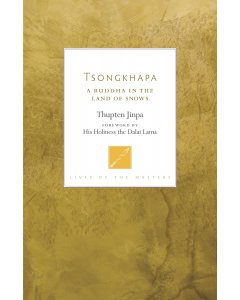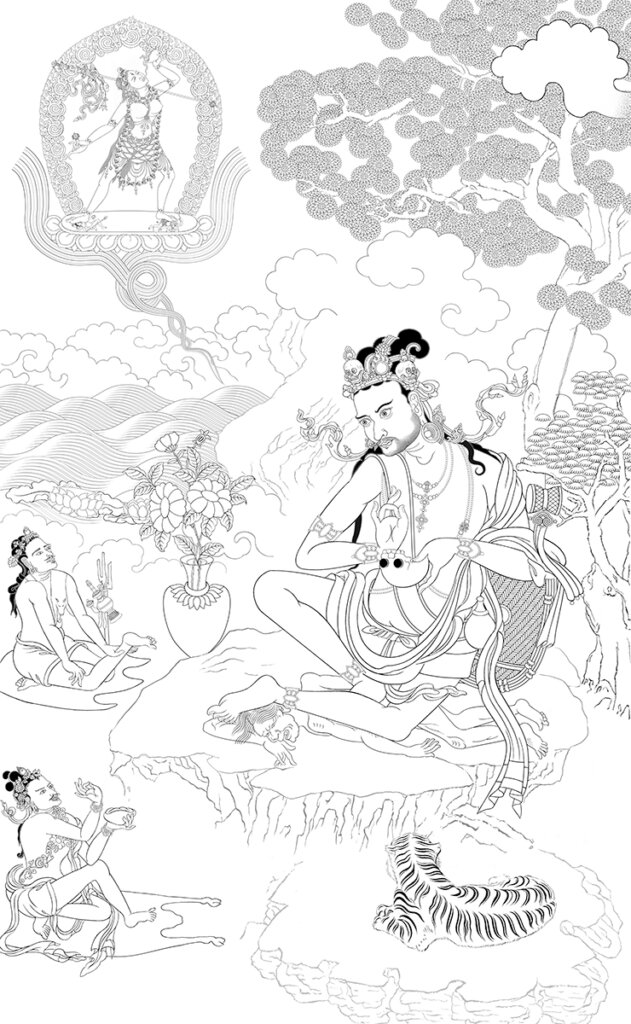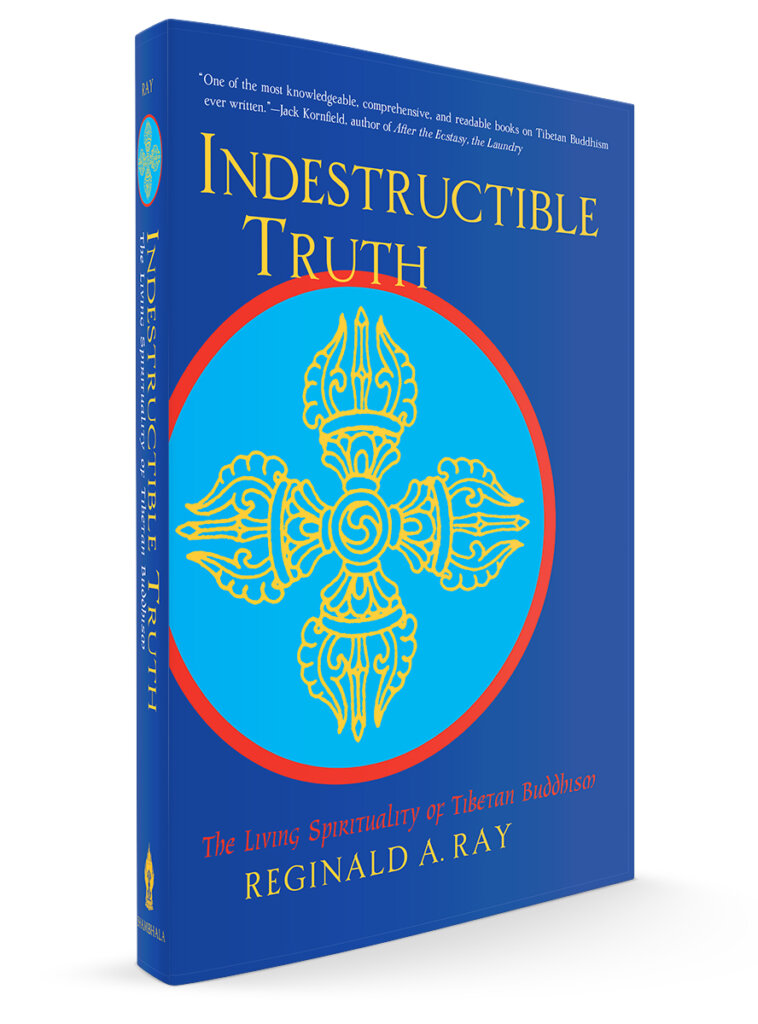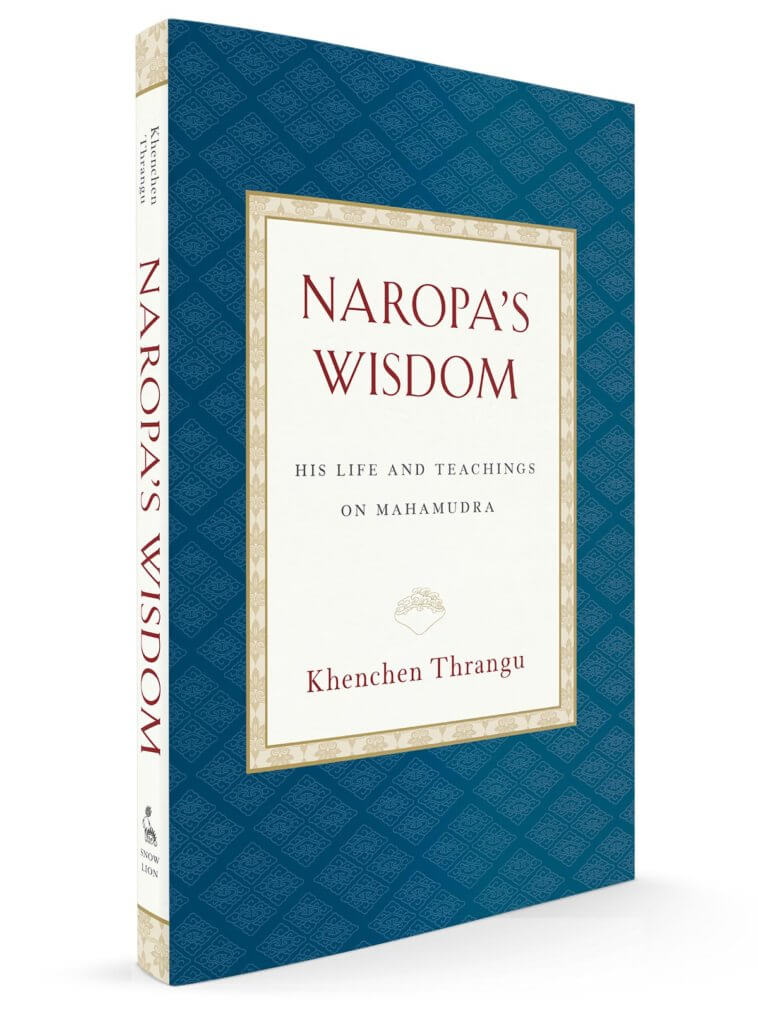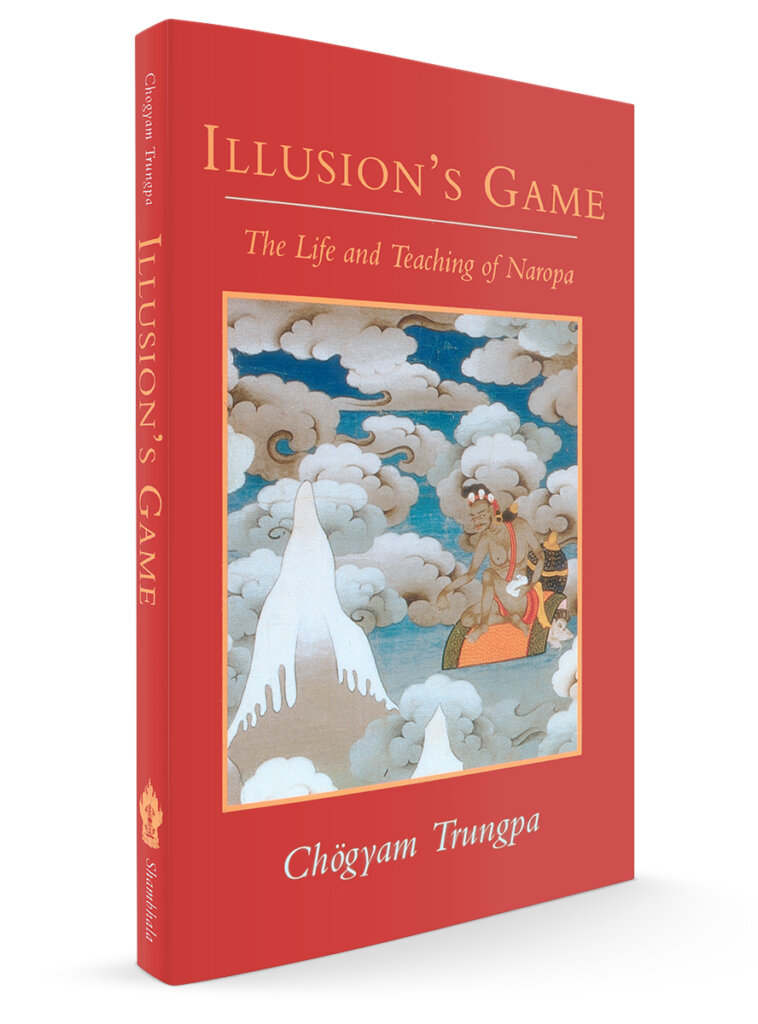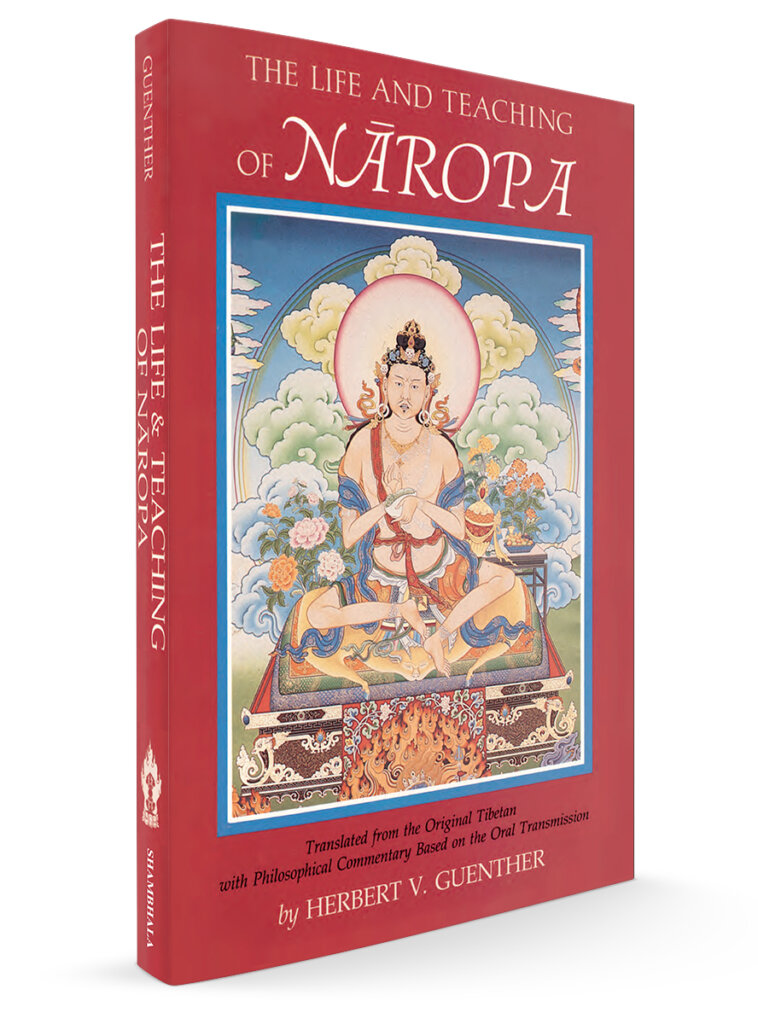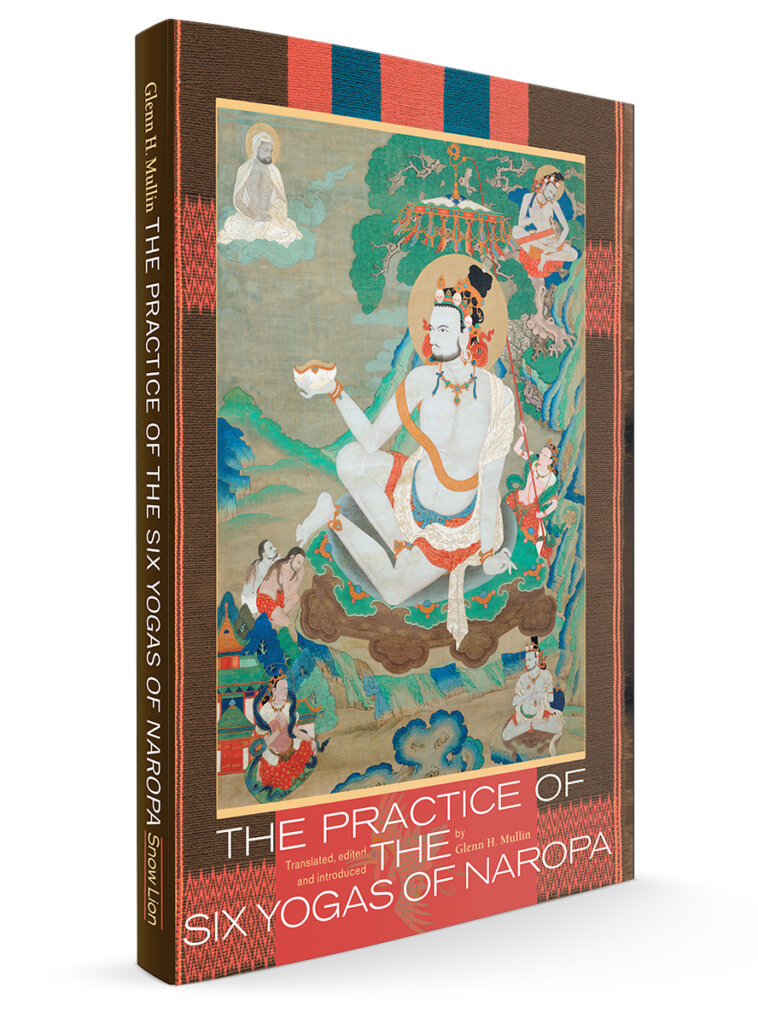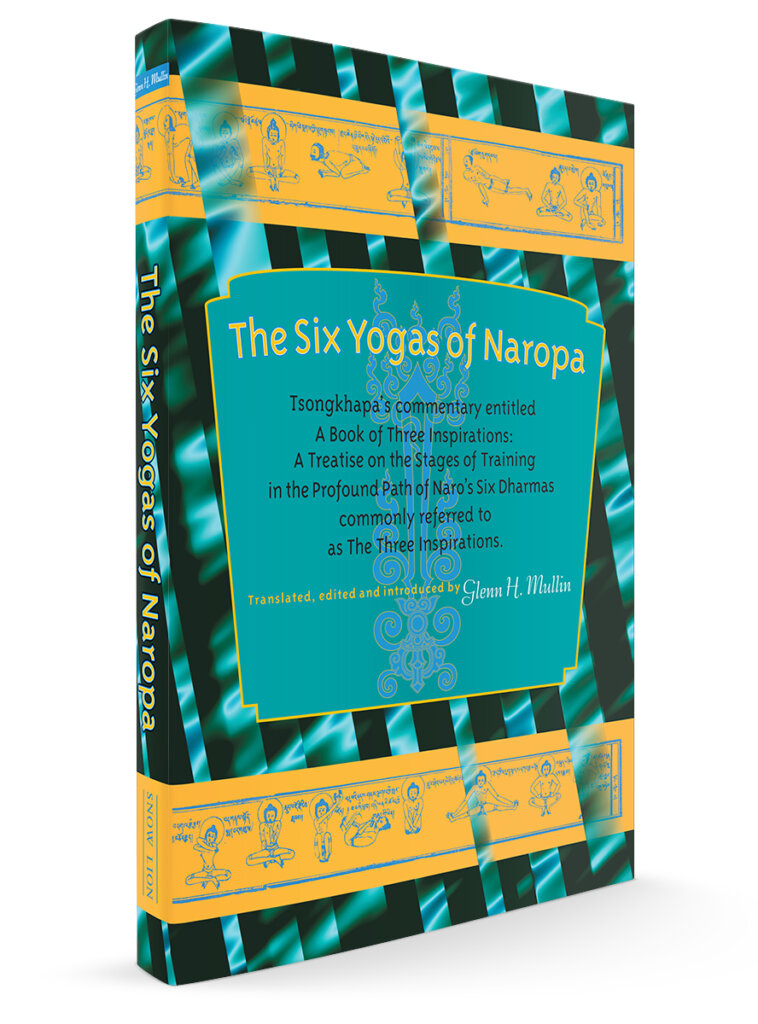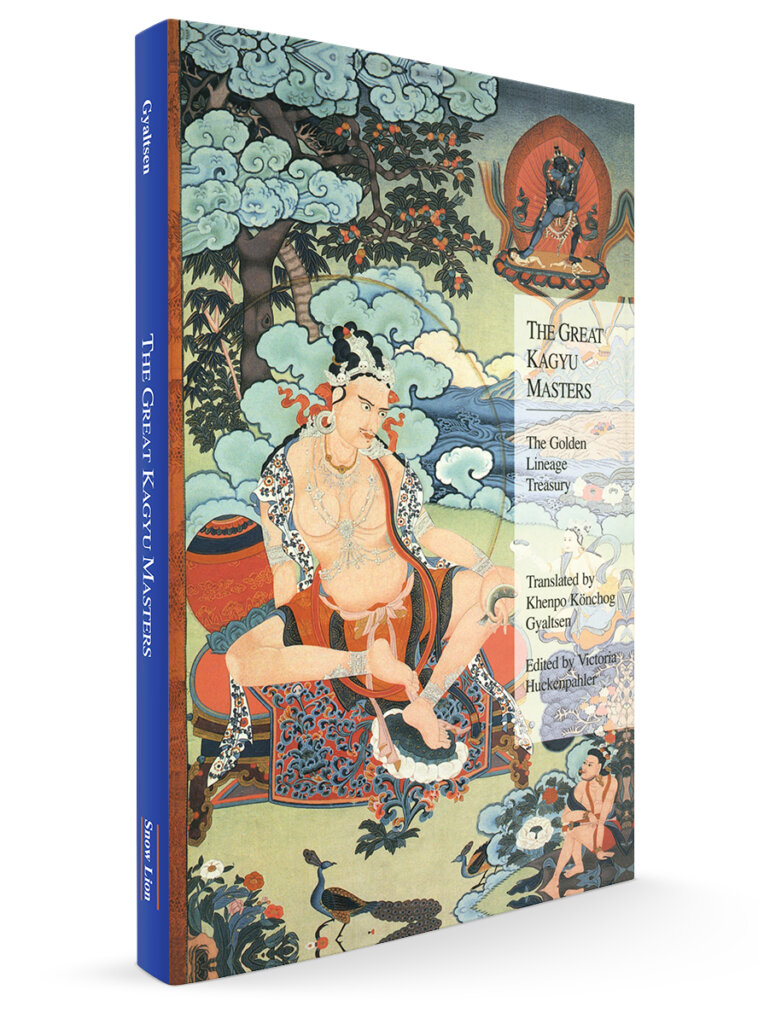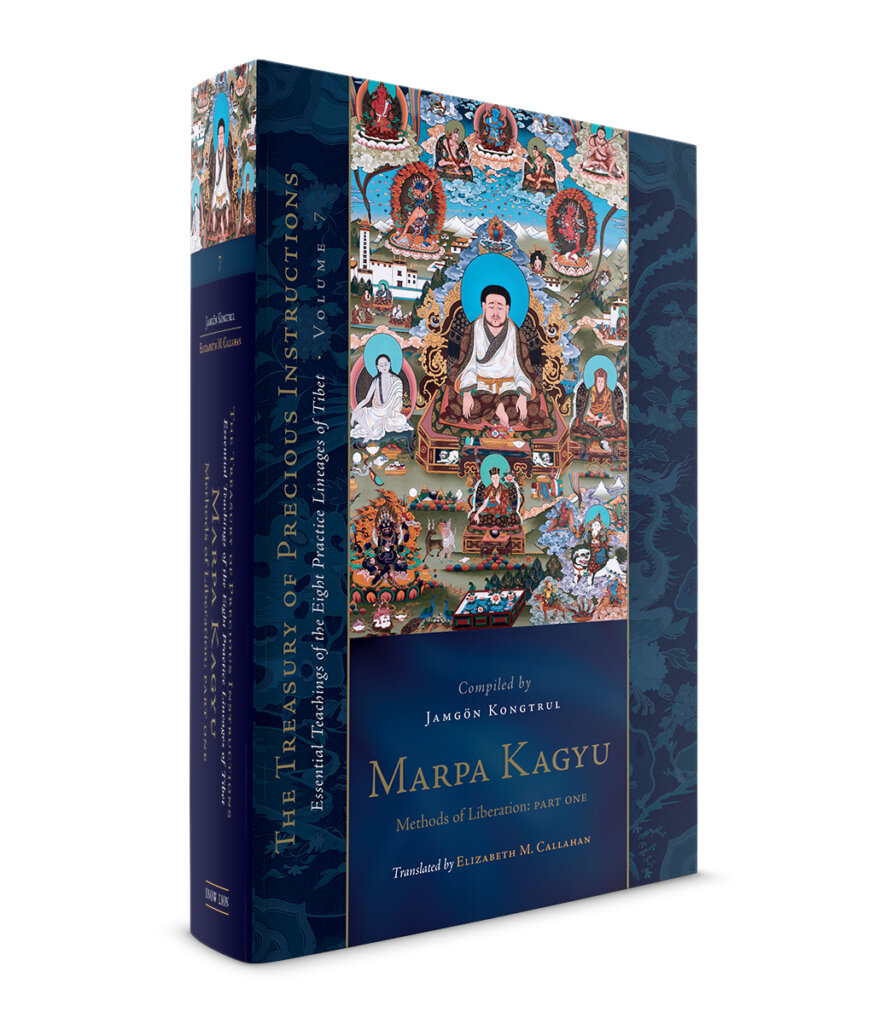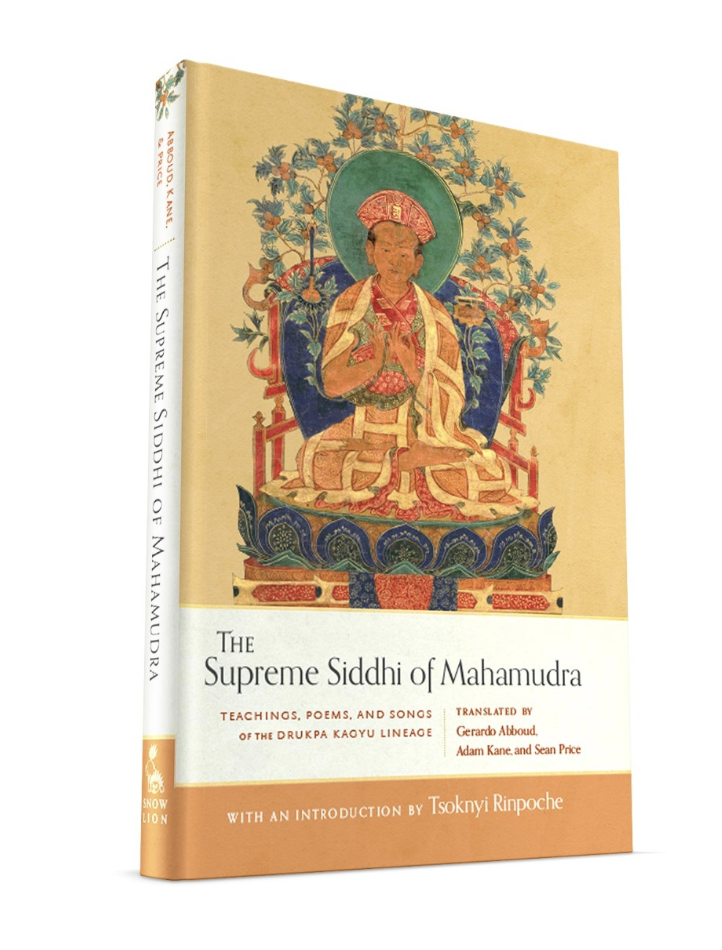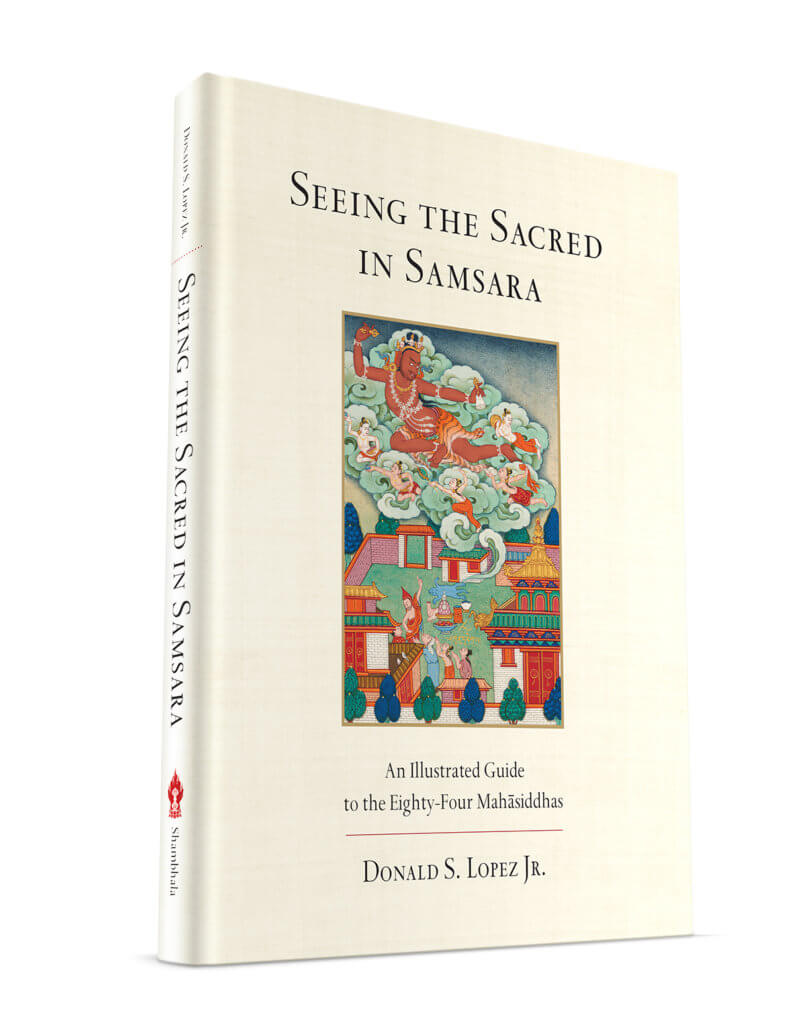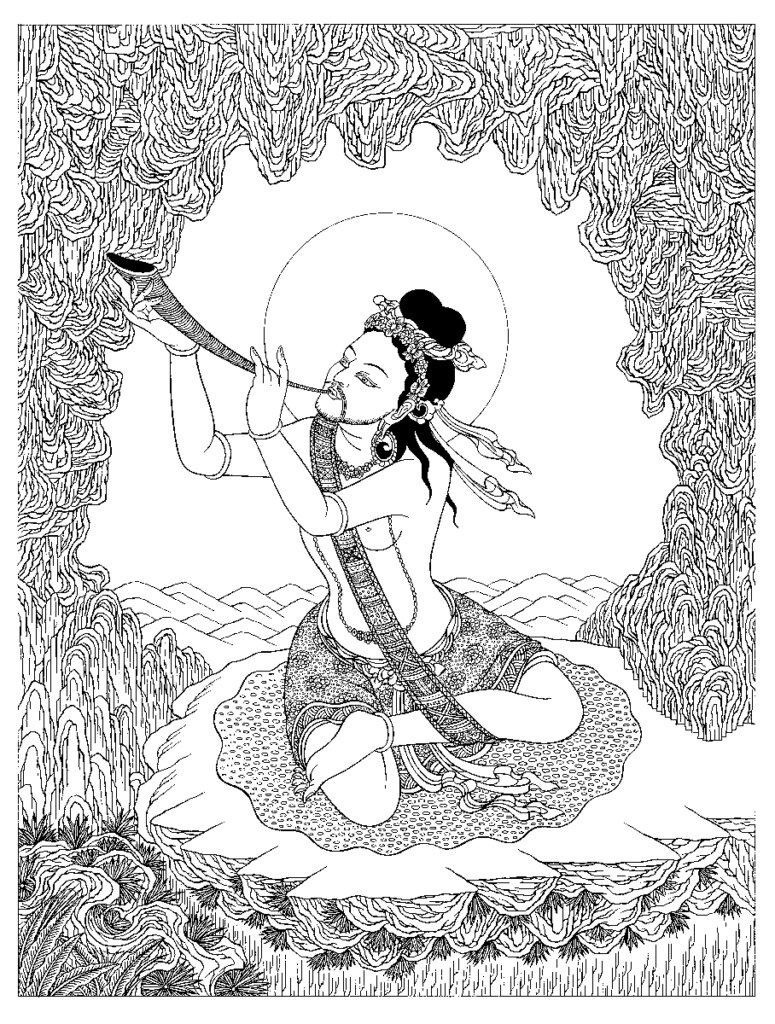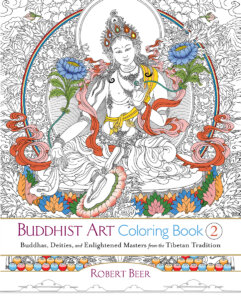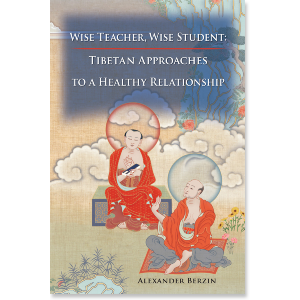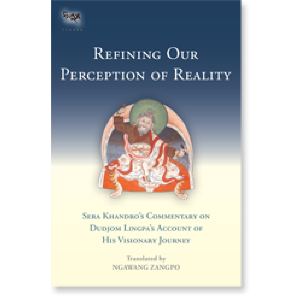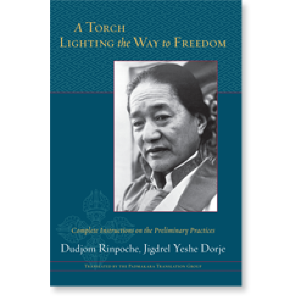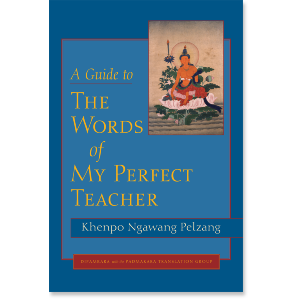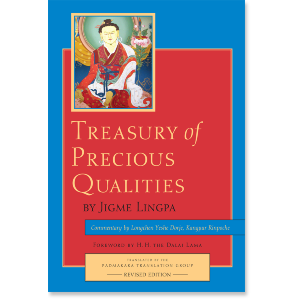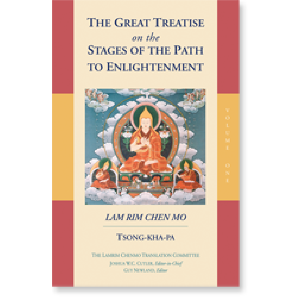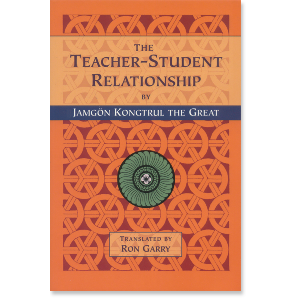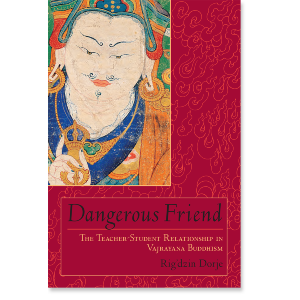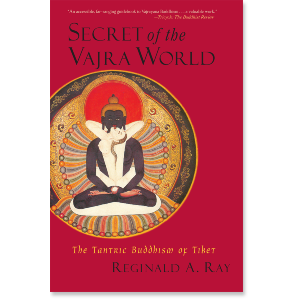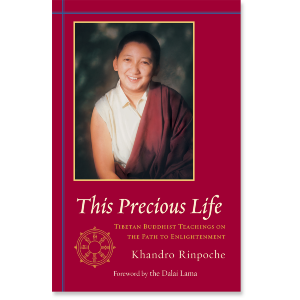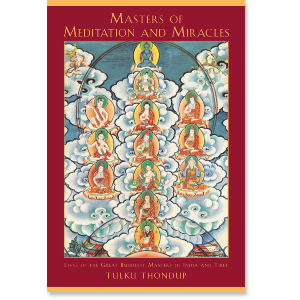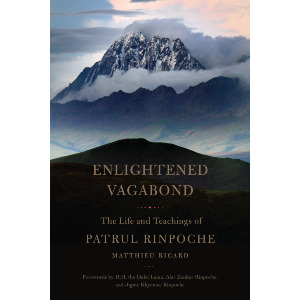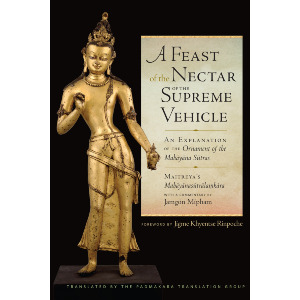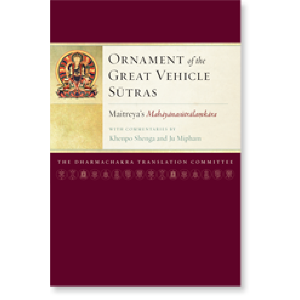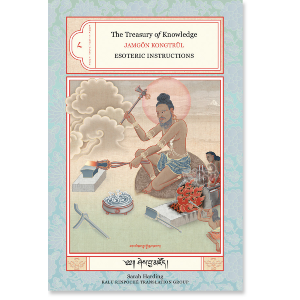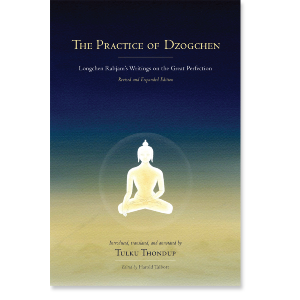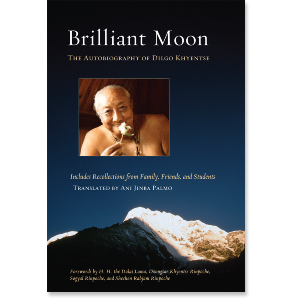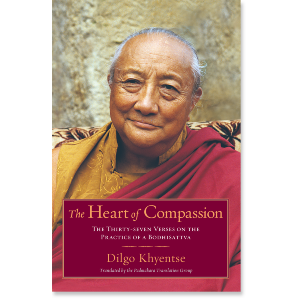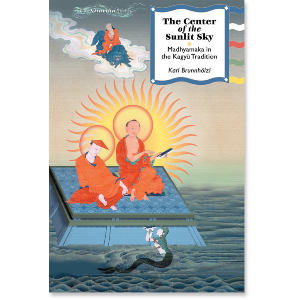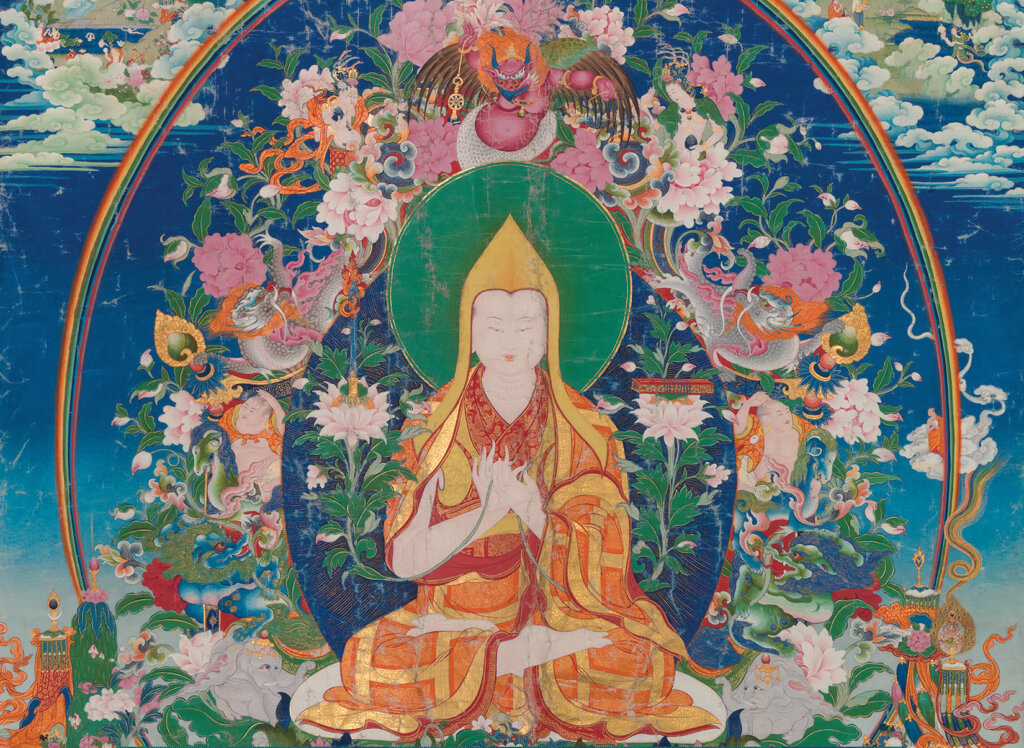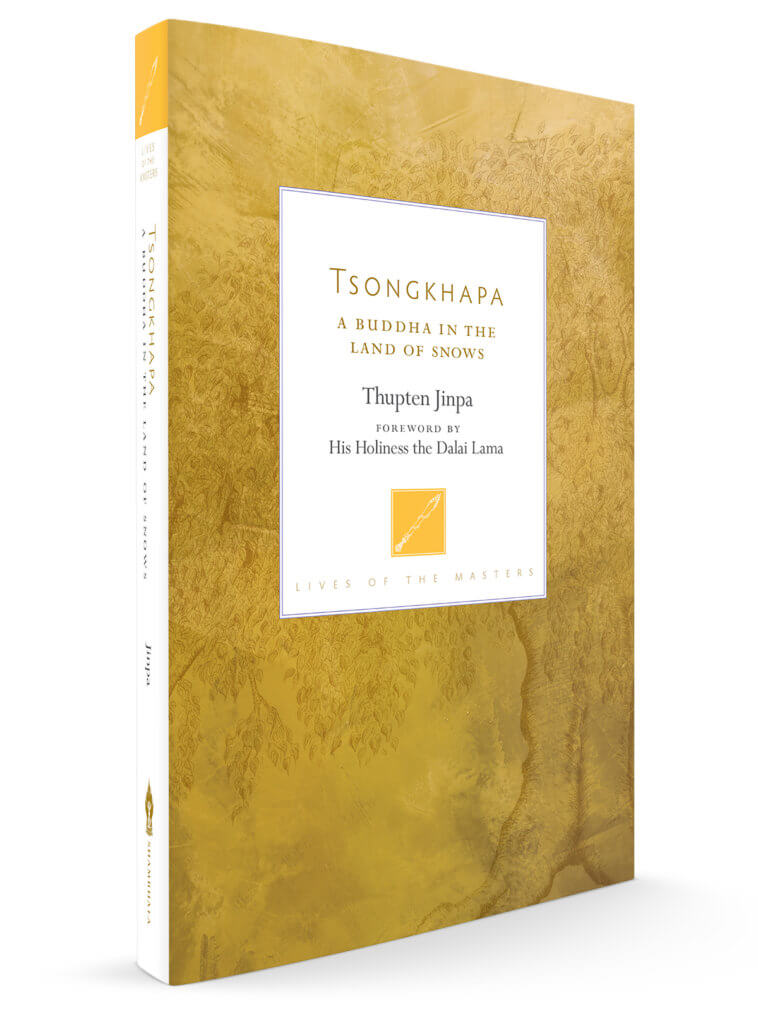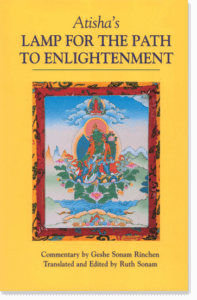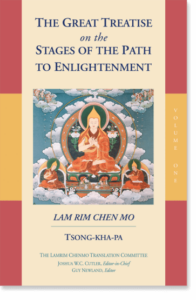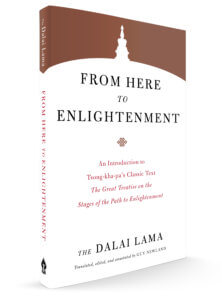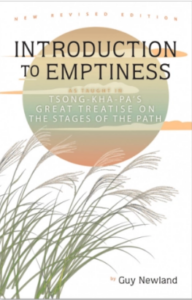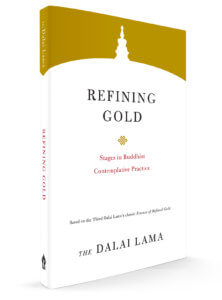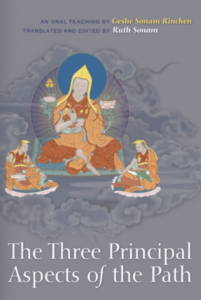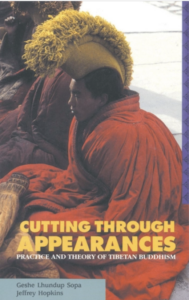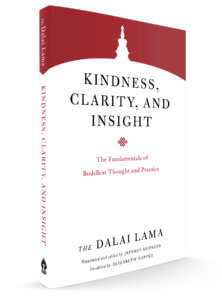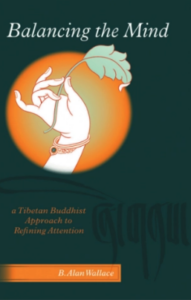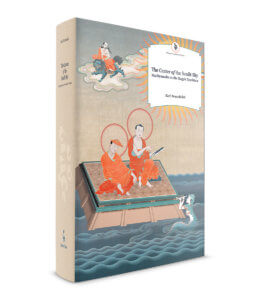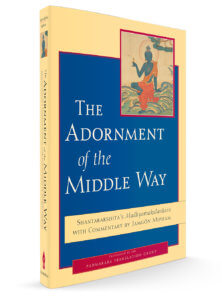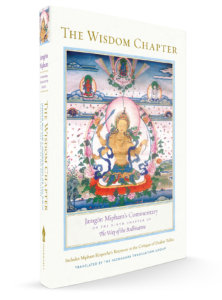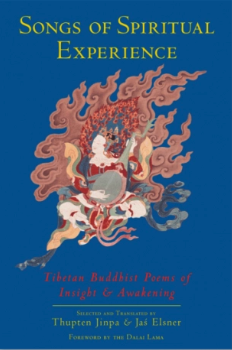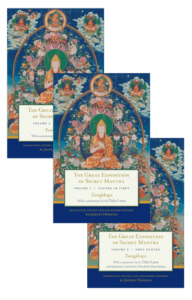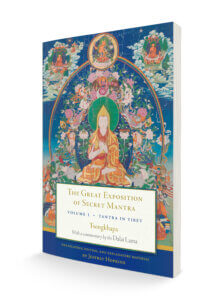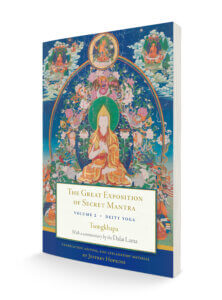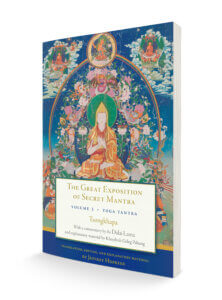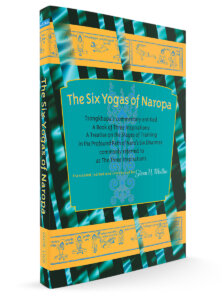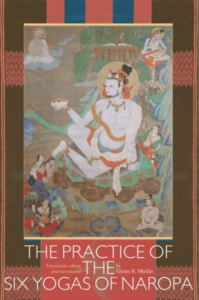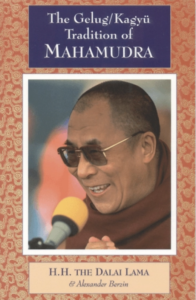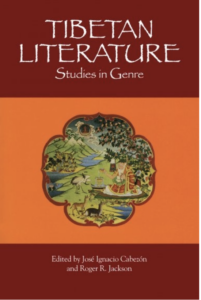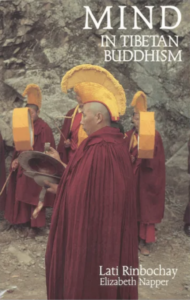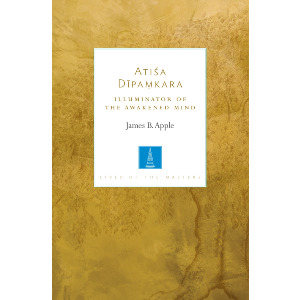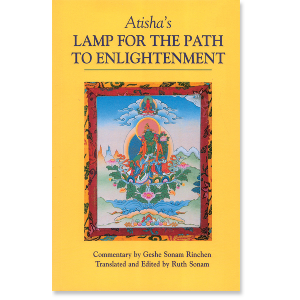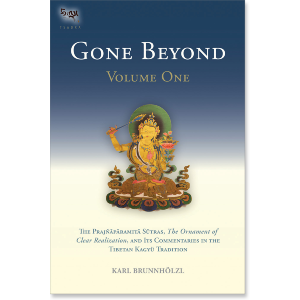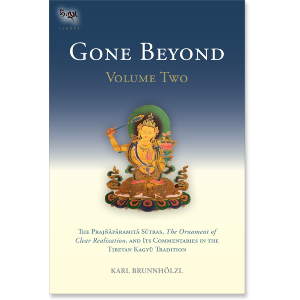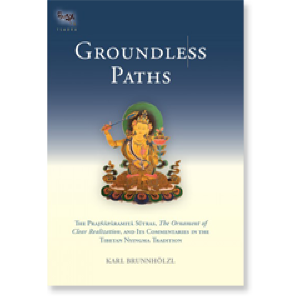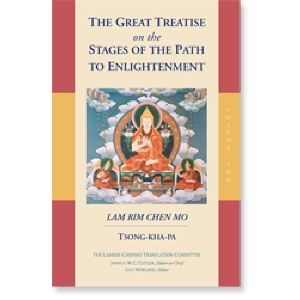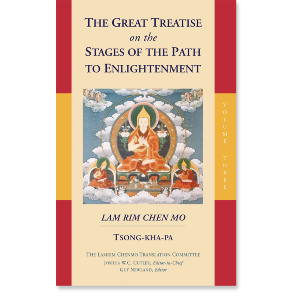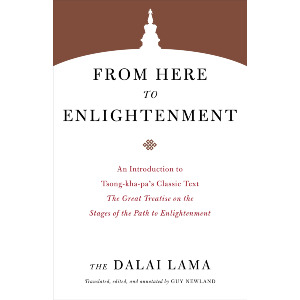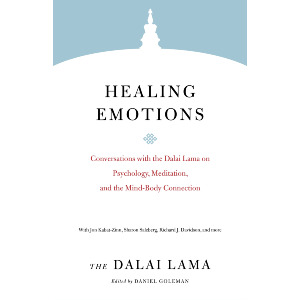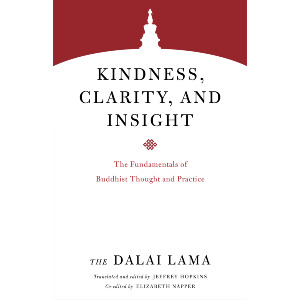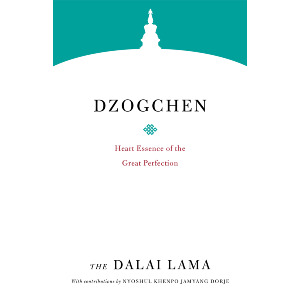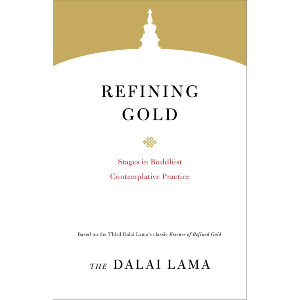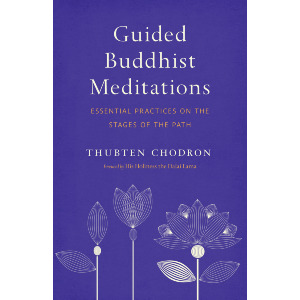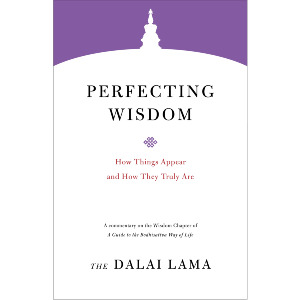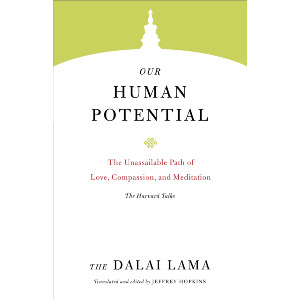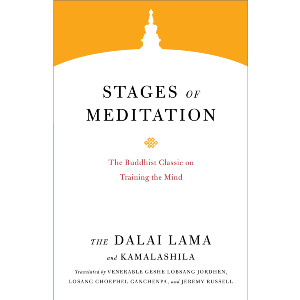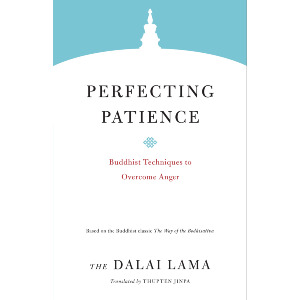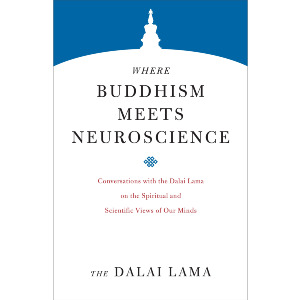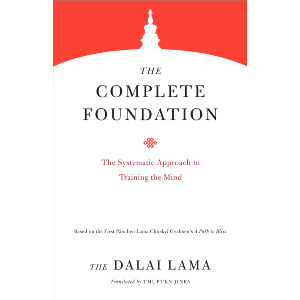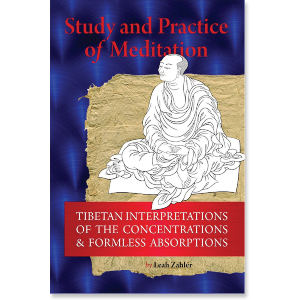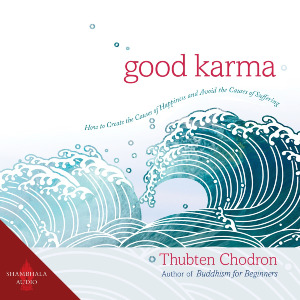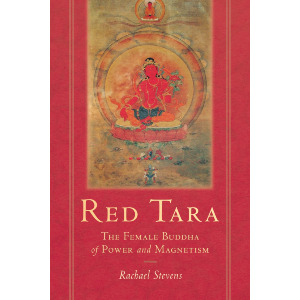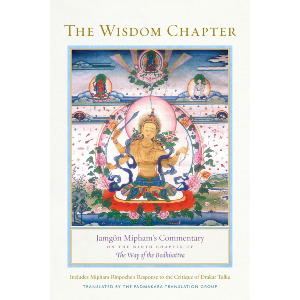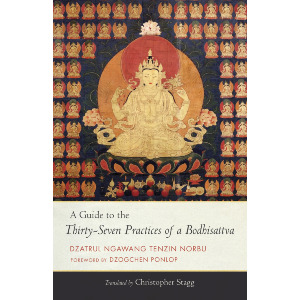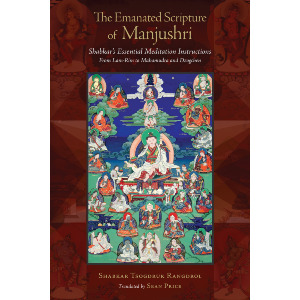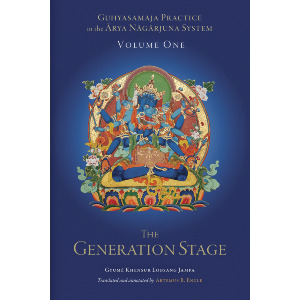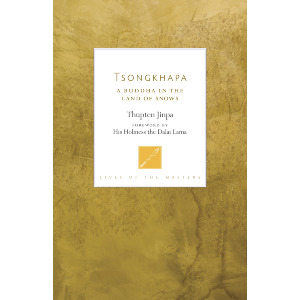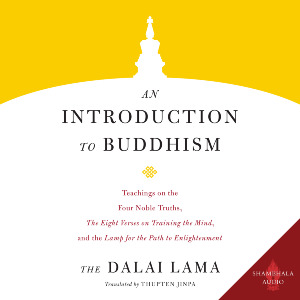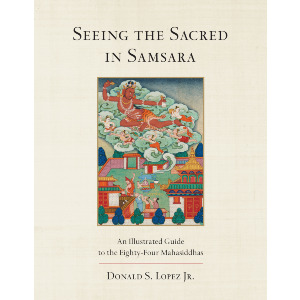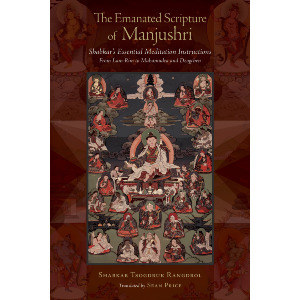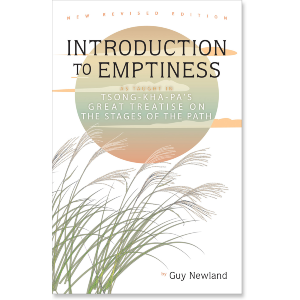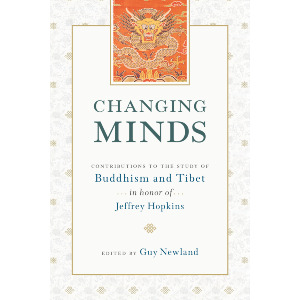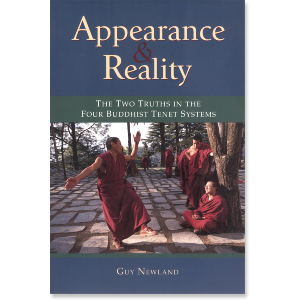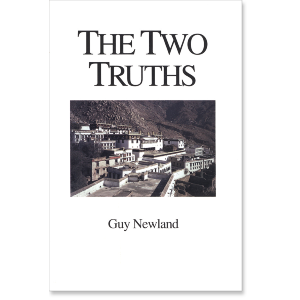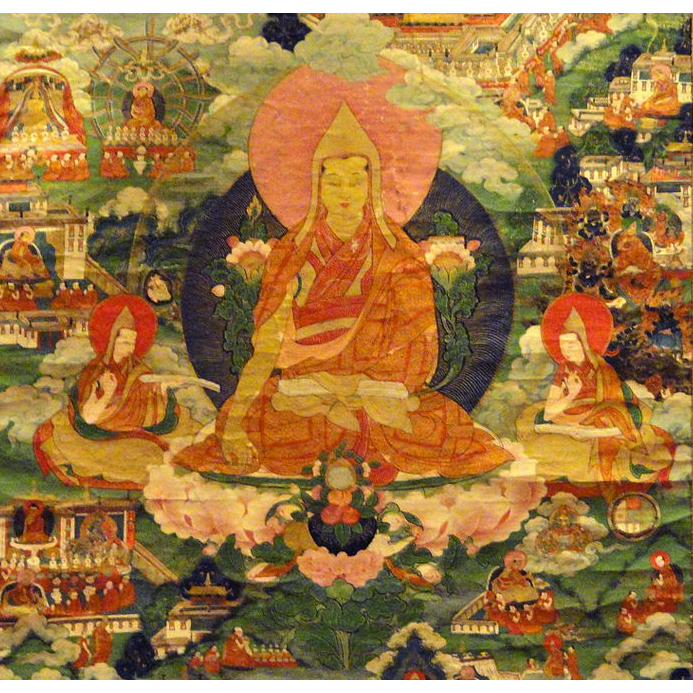

Tsongkhapa
Tsongkhapa (1357–1419), founder of the Gelug school of Tibetan Buddhism, was one of Tibet’s greatest philosophers and a prolific writer. His most famous work, The Great Treatise on the Stages of the Path, is a classic of Tibetan Buddhism.
Tsongkhapa
-
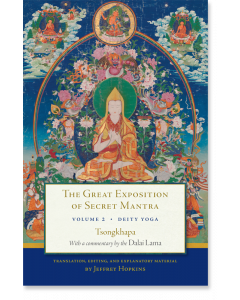 The Great Exposition of Secret Mantra, Volume 2$29.95- Paperback
The Great Exposition of Secret Mantra, Volume 2$29.95- PaperbackBy H.H. the Fourteenth Dalai Lama
By Tsongkhapa
Edited by Jeffrey Hopkins -
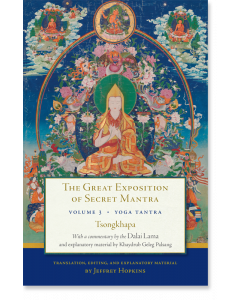 The Great Exposition of Secret Mantra, Volume 3$27.95- Paperback
The Great Exposition of Secret Mantra, Volume 3$27.95- PaperbackBy H.H. the Fourteenth Dalai Lama
By Tsongkhapa
Edited by Jeffrey Hopkins -
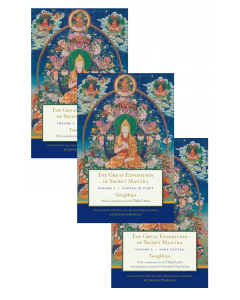 The Great Exposition of Secret Mantra
The Great Exposition of Secret MantraStarting at $27.95
By H.H. the Fourteenth Dalai Lama and Tsongkhapa
Edited by Jeffrey Hopkins -
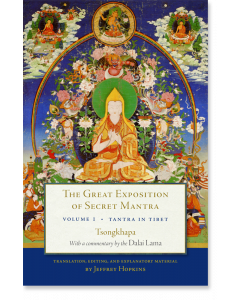 The Great Exposition of Secret Mantra, Volume 1$29.95- Paperback
The Great Exposition of Secret Mantra, Volume 1$29.95- PaperbackBy H.H. the Fourteenth Dalai Lama
Edited by Jeffrey Hopkins
By Tsongkhapa -
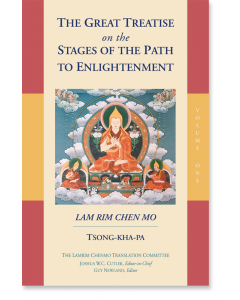 The Great Treatise on the Stages of the Path to Enlightenment (Volume 1)$34.95- Paperback
The Great Treatise on the Stages of the Path to Enlightenment (Volume 1)$34.95- PaperbackBy Tsong-kha-pa
Edited by Joshua Cutler
Translated by Lamrim Chenmo Translation Committee
Edited by Guy Newland -
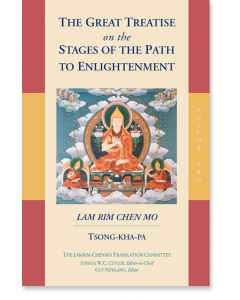 The Great Treatise on the Stages of the Path to Enlightenment (Volume 2)$28.95- Paperback
The Great Treatise on the Stages of the Path to Enlightenment (Volume 2)$28.95- PaperbackBy Tsong-kha-pa
Edited by Joshua Cutler
Translated by Lamrim Chenmo Translation Committee
Edited by Guy Newland -
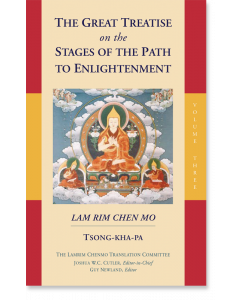 The Great Treatise on the Stages of the Path to Enlightenment (Volume 3)$34.95- Paperback
The Great Treatise on the Stages of the Path to Enlightenment (Volume 3)$34.95- PaperbackBy Tsong-kha-pa
Edited by Joshua Cutler
Translated by Lamrim Chenmo Translation Committee
Edited by Guy Newland -
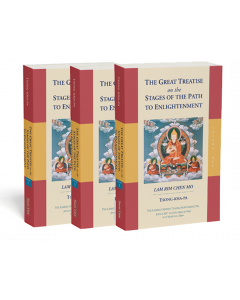 The Great Treatise on the Stages of the Path to Enlightenment Collection
The Great Treatise on the Stages of the Path to Enlightenment CollectionStarting at $28.95
By Tsongkhapa
-
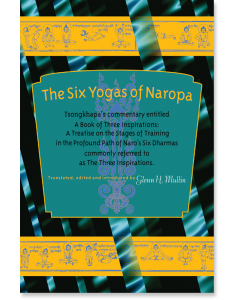 The Six Yogas of Naropa$39.95- Paperback
The Six Yogas of Naropa$39.95- PaperbackBy Tsong-kha-pa
Edited by Glenn H. Mullin
Translated by Glenn H. Mullin -
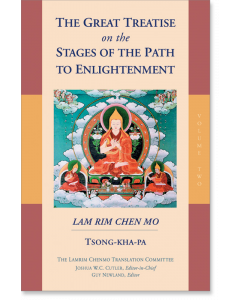 The Great Treatise on the Stages of the Path to Enlightenment: Volume Three$39.95- Hardcover
The Great Treatise on the Stages of the Path to Enlightenment: Volume Three$39.95- HardcoverBy Tsong-kha-pa
Edited by Joshua Cutler
Translated by Lamrim Chenmo Translation Committee
Edited by Guy Newland
GUIDES
Naropa: A Reader's Guide to the Great Master of Mahamudra

The following short biography of Naropa is adapted from Indestructible Truth: The Living Spirituality of Tibetan Buddhism:
Naropa, Tilopa’s primary disciple, is born in wealthy circumstances, the favored son of a kshatriya (ruling caste in India) family. At seventeen, he is compelled by his parents to marry. After eight years of marriage, however, he announces his intention to renounce the world. He and his wife agree to a divorce, and Naropa, like Tilopa, takes ordination into the monastic way. Unlike Tilopa, however, Naropa invests many years in intensive study, mastering the major branches and varieties of Buddhist texts, including the Vinaya, Sutras, and Abhidharma of the Hinayana, the Prajnaparamita of the Mahayana, and the tantras. Eventually, he rises to the top of his religious profession, becoming first a high-ranking scholar at Nalanda and then its supreme abbot. His fame as a scholar spreads everywhere, and he is considered unexcelled in his understanding of Buddhist doctrine.
At Nalanda, he has an extraordinary experience with a seeming ordinary old woman but one who it turns out has a profound effect on his life and sends him to find Tilopa.
At this moment, Tilopa appears, a blue-black man dressed in cotton trousers, with a topknot and bulging bloodshot eyes. He declares that ever since Naropa formed the intention to seek him, Tilopa has not been separate from him and that it was only Naropa’s defilements that blinded him to this fact. He tells Naropa that he is a worthy vessel, will indeed be able to receive the deepest teachings, and that he will accept him as a disciple.
For the next twelve years, Naropa is Tilopa’s disciple, undergoing a most demanding tutelage. He suffers immensely through all kinds of physical, psychological, and spiritual trials, torments, and tribulations. The rigor of his training is in direct measure, he understands, to the karmic accretions and obscurations that he has accumulated in his previous lives. Each of Tilopa’s teachings is a catastrophe for Naropa’s sense of personal identity, and in each instance he believes himself to have been irreparably and mortally harmed. In each case Tilopa reveals a deeper level of Naropa’s being, one that is open, clear, and resplendent, independent of the life and death of ego. Throughout this period, Tilopa says very little, and Naropa’s instruction occurs in nonverbal ways, through his own pain and through symbolic gestures that he must assimilate. No security and certainly no confirmation are ever given, and Naropa is able to persevere out of complete devotion to Tilopa and his conviction that he has no other options.
After twelve years of training, one day Naropa is standing with Tilopa on a barren plain. Tilopa remarks that the time has now come for him to offer Naropa the much-sought-after oral instructions, the transmission of dharma. When Tilopa demands an offering, Naropa, who has nothing, offers his own fingers and blood. As Lama Taranatha recounts the event.
Then Tilopa, having collected the fingers of Naropa, hit him in the face with a dirty sandal and Naropa instantly lost consciousness. When he regained consciousness, he directly perceived the ultimate truth, the suchness of all reality, and his fingers were restored. He was now granted the complete primary and subsidiary oral instructions. Thereupon, Naropa became a lord of yogins.
From Tilopa, Naropa receives the transmissions of mahamudra, the six inner yogas, and the anuttara-yoga tantras, and himself becomes a realized siddha in the tradition of his master. Naropa is subsequently seen sometimes roaming through the jungles, sometimes defeating heretics, sometimes in male-female aspect (that is, in union with his consort, a mark of his realization), hunting deer with a pack of hounds, at other times performing magical feats, at still other times acting like a small child, playing, laughing, and weeping. As a realized master, he accepts disciples, and through all of his activities, however benign or unconventional and shocking they may be, he reveals the awakened state beyond thought, imbued with wisdom, compassion, and power. He is also a prolific author whose previous scholarly training enables him to be an eloquent writer on Vajrayana topics, evidenced by his works surviving in the Tenjur.
Naropa is a pivotal figure in the evolution of the Kagyu¨ lineage for the way in which he joins tantric practice and more traditional scholarship, unreasoning devotion and the rationality of intellect. Through him, Tilopa’s profound and untamed lineage is brought out of the jungles of east India and given a form which the Tibetan householder Marpa can receive.
Essential Texts by and about Naropa
Paperback | Ebook
$19.95 - Paperback
Naropa's Wisdom: His Life and Teachings on Mahamudra
As the disciple of Tilopa and the guru of Marpa the Translator, Naropa is one of the accomplished lineage holders of the Kagyu tradition of Tibetan Buddhism. He expressed his realization in the form of spiritual songs, pithy yet beautiful poems that he sung spontaneously. In this book, Khenchen Thrangu, a contemporary Karma Kagyu master, first tells the story of Naropa’s life and explains the lessons we can learn from it and then provides verse-by-verse commentary on two of his songs. Both songs contain precious instructions on Mahamudra, the direct experience of the nature of one's mind, which in this tradition is the primary means to realize ultimate reality and thus attain buddhahood.
Thrangu Rinpoche’s teaching on the first song, The View, Concisely Put, explains the view of Mahamudra in a manner suitable for Western students who are new to the subject. The second song, The Summary of Mahamudra, contains all the key points of the view, meditation, conduct, and fruition of Mahamudra. Thrangu Rinpoche speaks plainly, directly, and without using any technical jargon to Westerners eager to learn the fundamentals of the Mahamudra path to enlightenment from a recognized master. As Thrangu Rinpoche says, “Mahamudra is a practice that can be done by anyone. It is an approach that engulfs any practitioner with tremendous blessings that make it very effective and easy to implement. This is especially true in our present time and especially true for Westerners because in the West there are very few obstacles in the practice of Mahamudra.”
Paperback | Ebook
$19.95 - Paperback
Illusion's Game: The Life and Teaching of Naropa
In what he calls a "200 percent potent" teaching, Chögyam Trungpa reveals how the spiritual path is a raw and rugged "unlearning" process that draws us away from the comfort of conventional expectations and conceptual attitudes toward a naked encounter with reality. The tantric paradigm for this process is the story of the Indian master Naropa (1016–1100), who is among the enlightened teachers of the Kagyu lineage of the Tibetan Buddhism. Naropa was the leading scholar at Nalanda, the Buddhist monastic university, when he embarked upon the lonely and arduous path to enlightenment. After a series of daunting trials, he was prepared to receive the direct transmission of the awakened state of mind from his guru, Tilopa. Teachings that he received, including those known as the six doctrines of Naropa, have been passed down in the lineages of Tibetan Buddhism for a millennium.
Trungpa Rinpoche's commentary shows the relevance of Naropa's extraordinary journey for today's practitioners who seek to follow the spiritual path. Naropa's story makes it possible to delineate in very concrete terms the various levels of spiritual development that lead to the student's readiness to meet the teacher's mind. Trungpa thus opens to Western students of Buddhism the path of devotion and surrender to the guru as the embodiment and representative of reality.
Paperback | Ebook
$34.95 - Paperback
The Life and Teaching of Naropa
Translated by Herbert V. Guenther
In the history of Tibetan Buddhism, the eleventh-century Indian mystic Nâropa occupies an unusual position, for his life and teachings mark both the end of a long tradition and the beginning of a new and rich era in Buddhist thought. Nâropa's biography, translated by the world-renowned Buddhist scholar Herbert V. Guenther from hitherto unknown sources, describes with great psychological insight the spiritual development of this scholar-saint. It is unique in that it also contains a detailed analysis of his teaching that has been authoritative for the whole of Tantric Buddhism.
This modern translation is accompanied by a commentary that relates Buddhist concepts to Western analytic philosophy, psychiatry, and depth psychology, thereby illuminating the significance of Tantra and Tantrism for our own time. Yet above all, it is the story of an individual whose years of endless toil and perseverance on the Buddhist path will serve as an inspiration to anyone who aspires to spiritual practice.
The Six Yogas of Naropa
The Six Yogas of Naropa
The Six Yogas of Naropa are a set of advanced tantric practices that can only be undertaken under the close guidance of a qualified teacher. We do not recommend these books unless one is under such guidance as misunderstanding is very likely.
Paperback | Ebook
$27.95 - Paperback
The Practice of the Six Yogas of Naropa
Edited by Glenn Mullin
This book on the Six Yogas contains important texts on this esoteric doctrine, including original Indian works by Tilopa and Naropa and writings by great Tibetan lamas. It contains an important practice manual on the Six Yogas as well as other works that discuss the practices, their context, and the historical continuity of this most important tradition.
- The Oral Instruction of the Six Yogas by Tilopa
- Vajra Verses of the Whispered Tradition by Naropa
- Notes on "A Book of Three Inspirations" by Je Sherab Gyatso
- Handprints of the Profound Path of the Six Yogas of Naropa by Gyalwa Wensapa
- A Practice Manual on the Six Yogas of Naropa by Tsongkhapa
- The Golden Key: A Profound Guide to the Six Yogas of Naropa by the First Panchen Lama
Paperback | Ebook
$39.95 - Paperback
The Six Yogas of Naropa: Tsongkhapa's Commentary
By Tsongkhapa, translated and introduced by Glenn Mullin
Tsongkhapa's commentary entitled A Book of Three Inspirations: A Treatise on the Stages of Training in the Profound Path of Naro's Six Dharmas is commonly referred to as The Three Inspirations. Anyone who has read more than a few books on Tibetan Buddhism will have encountered references to the Six Yogas of Naropa, a preeminent yogic technology system. The six practices—inner heat, illusory body, clear light, consciousness transference, forceful projection, and bardo yoga—gradually came to pervade thousands of monasteries, nunneries, and hermitages throughout Central Asia over the past five and a half centuries.
More Books Featuring Naropa
Paperback | Ebook
$27.95 - Paperback
The Great Kagyu Masters: The Golden Lineage Treasury
Compiled by Dorje Dze Öd, translated by Khenchen Konchog Gyaltshen Rinpoche
The Golden Lineage Treasury was compiled by Dorje Dze Öd a great master of the Drikung lineage active in the Mount Kailasjh region of Western Tibet. This text of the Kagyu tradition profiles and the forefathers of the tradition including Vajradhara, the Buddha, Tilopa, Naropa, the Four Great Dharma Kings of Tibet, Marpa, Milarepa, Atisha, Gampopa, Phagmodrupa, Jigten Sumgon, and more.
The chapter on Naropa is 45 pages long.
Hardcover | Ebook
$49.95 - Hardcover
Marpa Kagyu, Part One - Methods of Liberation: Essential Teachings of the Eight Practice Lineages of Tibet, Volume 7
The Treasury of Precious Instructions
By Jamgon Kongtrul Lodro Thaye
The seventh volume of the series, Marpa Kagyu, is the first of four volumes that present a selection of core instructions from the Marpa Kagyu lineage of Tibetan Buddhism. This lineage is named for the eleventh-century Tibetan Marpa Chokyi Lodrö of Lhodrak who traveled to India to study the sutras and tantras with many scholar-siddhas, the foremost being Naropa and Maitripa. The first part of this volume contains source texts on mahamudra and the six dharmas by such famous masters as Saraha and Tilopa. The second part begins with a collection of sadhanas and abhisekas related to the Root Cakrasamvara Aural Transmissions, which are the means for maturing, or empowering, students. It is followed by the liberating instructions, first from the Rechung Aural Transmission. This section on instructions continues in the following three Marpa Kagyu volumes. Also included are lineage charts and detailed notes by translator Elizabeth M. Callahan.
The piece by Naropa in this volume include:
- Summary Verses on Mahāmudrā
- Authoritative Texts in Verse: Mahāsiddha Nāropa’s Cycle on the Six
Dharmas - Vajra Song Summarizing the Six Dharmas: The Scholar-Mahāsiddha
Nāropa’s Instructions to the Lord of Yogins Marpa
Hardcover | Ebook
$24.95 - Hardcover
The Supreme Siddhi of Mahamudra: Teachings, Poems, and Songs of the Drukpa Kagyu Lineage
Translated by Gerardo Abboud, Sean Price, and Adam Kane
The Drukpa Kagyu lineage is renowned among the traditions of Vajrayana Buddhism for producing some of the greatest yogis from across the Himalayas. After spending many years in mountain retreats, these meditation masters displayed miraculous signs of spiritual accomplishment that have inspired generations of Buddhist practitioners. The teachings found here are sources of inspiration for any student wishing to genuinely connect with this tradition.
These translations include Mahamudra advice and songs of realization from major Tibetan Buddhist figures such as Gampopa, Tsangpa Gyare, Drukpa Kunleg, and Pema Karpo, as well as modern Drukpa masters such as Togden Shakya Shri and Adeu Rinpoche. This collection of direct pith instructions and meditation advice also includes an overview of the tradition by Tsoknyi Rinpoche.
The second chapter, on Naropa, is a translation of the Condensed Veses of Mahamudra, known in Sanskrit Mahāmudrāsaṃjñāsaṃhitā as and in Tibetan as (Chakgya Chenpo Tsig Dupa (Phyag rgya chen po’i tshig bsdus pa).
Combined with guidance from a qualified teacher, these teachings offer techniques for resting in the naturally pure and luminous state of our minds. As these masters make clear, through stabilizing the meditative experiences of bliss, clarity, and nonthought, we will be liberated from suffering in this very life and will therefore be able to benefit countless beings.
Translator on Gerardo Abboud on The Supreme Siddhi of Mahamudra
Hardcover | Ebook
$29.95 - Hardcover
Seeing the Sacred in Samsara: An Illustrated Guide to the Eighty-Four Mahāsiddhas
By Donald S. Lopez Jr.
This exquisite full-color presentation of the lives of the eighty-four mahāsiddhas, or “great accomplished ones,” offers a fresh glimpse into the world of the famous tantric yogis of medieval India. The stories of these tantric saints have captured the imagination of Buddhists across Asia for nearly a millennium. Unlike monks and nuns who renounce the world, these saints sought the sacred in the midst of samsara. Some were simple peasants who meditated while doing manual labor. Others were kings and queens who traded the comfort and riches of the palace for the danger and transgression of the charnel ground. Still others were sinners—pimps, drunkards, gamblers, and hunters—who transformed their sins into sanctity.
This book includes striking depictions of each of the mahāsiddhas by a master Tibetan painter, whose work has been preserved in pristine condition. Published here for the first time in its entirety, this collection includes details of the painting elements along with the life stories of the tantric saints, making this one of the most comprehensive works available on the eighty-four mahāsiddhas.
The Naropa image from this book is pictured at the top of this page and explains what is being depicted.
Additional Resources on Tilopa
Lotsawa House hosts at least one work by Naropa as well as several where he features. 

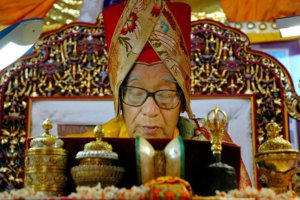
The Role of the Teacher in Tibetan Buddhism: A Reader's Guide to the Teacher-Student Relationship

To truly understand Tibetan Buddhism, one must come to grips with the unique role of the teacher, the dynamics of the teacher-student relationship, and the possibilities that having a teacher can open up.
Tibetan Buddhism is composed of the Vajrayana or Tantric teachings on top of a foundation of the Sutrayana (vehicle of the Sutras), the core teachings of what are sometimes called the Sravakayana and the Mahayana. In the context of the Sutrayana, a relationship with a teacher roughly maps to the categories of a pratimoksha master and a master of the bodhisattva vows, but there is a wide scope of possibilities and overlap within these roles. The teacher imparts, for example, important points on shamatha or vipashyana meditation, philosophy, or techniques like mind training (lojong), and these are akin to the role of teachers in other Buddhist traditions.
But in the relationship with a male or female vajra master in the context of tantric teachings, including Mahamudra and Dzogchen, the teacher and student have very specific commitments to each other, which is a very different situation. While this relationship may very well incorporate the elements of the relationship with a Sutrayana teacher, it is important for people to understand that a Vajrayana teacher is not really akin to the role of the Zen priest or the spiritual friend (kalyāṇamitta) of the Pali tradition of Buddhism, let alone the Hindu Guru, therapist, or a modern-day life coach. The practice of Guru Yoga (see sidebar below), whereby the student visualizes their teacher in the form of an enlightened being is one example of how different things are in this context. The relationship is much more central and is an essential mechanism for making great strides on the path.
That is why traditional texts encourage people to spend up to 12 years carefully considering whether a teacher of Vajrayana is suitable for them. They are not encouraging people to be wishy-washy and put off making a commitment; rather, this number underlines the importance of choosing a teacher very carefully.
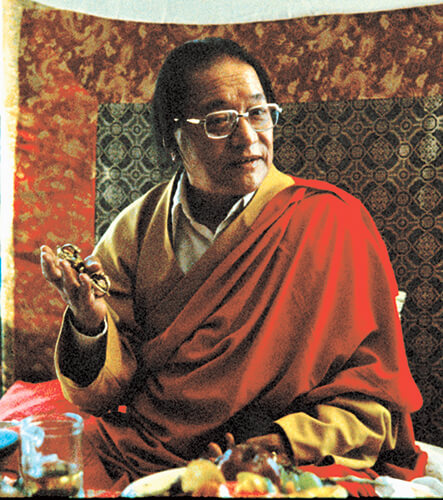
The benefits are immeasurable and are not accessible without a teacher. The great 20th-century master Dudjom Rinpoche gives some traditional examples to demonstrate the importance:
Ordinary, childlike beings are incapable of proceeding even vaguely in the same direction as the perfect path by the strength of their own minds, so they need first to examine and then to follow a qualified diamond master. Diamond masters are the root that causes us to correctly engage in the whole Buddhadharma in general and especially to follow the path properly. They are knowledgeable and experienced guides for inexperienced travellers setting out on a journey, powerful escorts for those who are travelling to dangerous places, ferrymen steering the boat for people crossing a river. Without them, nothing is possible. This is reiterated in countless scriptures.
Recently, there has been a lot of news and discussion in the media, Buddhist and otherwise, around the role of the teacher in Buddhism—in particular, Tibetan Buddhism. This mostly relates to a small handful of teachers (including the leader of Shambhala International, an organization totally unaffiliated with Shambhala Publications) against whom there have been serious allegations of abuse of power, some of it sexual. Many of these articles have been read by a younger generation of Westerners curious about Buddhism and other spiritual traditions but suspicious of hierarchy, organized religion, and spiritual leaders with perceived authority. This media attention seems to validate their suspicions.
But however bad some of these cases are—and it should go without saying that someone who is causing harm is acting in complete opposition to the Buddhadharma—a teacher harming or taking advantage of a student is an unacceptable exception to the norm; it is a rare aberration in an incredible system that has benefited millions of people East and West in the most profound and transformative ways.
These aberrations are not new. People are human, and throughout Buddhist history (or any tradition) there has been the occasional charlatan or flawed leader—as the discussion of how to avoid a bad teacher in many of the texts below make plain. But the fact is that there are so many highly educated, spiritually accomplished (typically following many years in retreat), caring, selfless teachers in this tradition, and it is a shame that people who do not know better are being exposed, online and in print, only to the exceptions rather than the norm and the potential.
Specifically, much of the recent coverage and discussion online and in print around the role of the guru or lama has reflected a deep misunderstandings of the role of the teacher in Tibetan Buddhism and has therefore created a lot of confusion. The best way for a student to find the right teacher who can lead them far along the path to enlightenment is to have a solid ground in understanding what the roles are, to be aware of the cultural dynamics at play, and to know which qualities to seek and which to avoid.
So, we are pleased to share this Reader’s Guide to help those interested in understanding the role, importance, and centrality of the guru or lama and the transformative power of the student-teacher relationship. We hope this will better prepare those pursuing this path to understand the choices they are making and set them up for spiritual success and accomplishment.
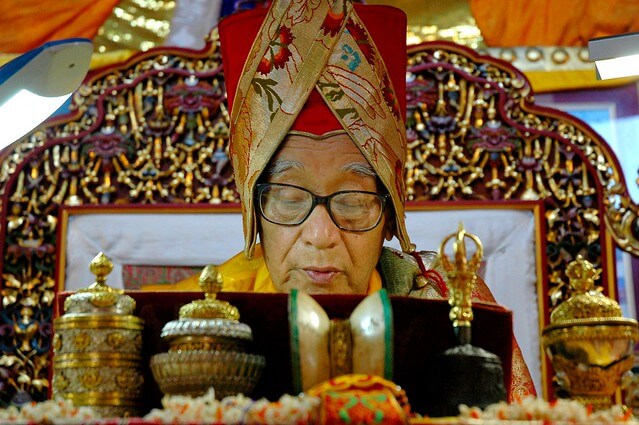


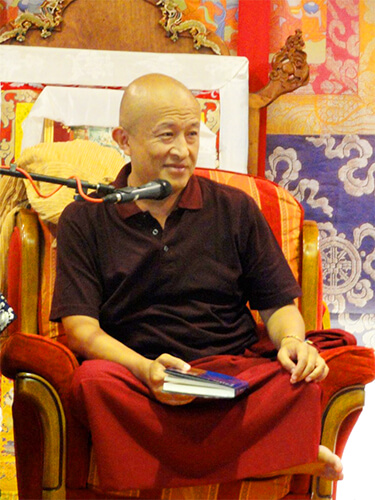
Perhaps the book that addresses head-on the contemporary concerns and confusion about the role of the teacher—from gender inequality to power dynamics and bad apples—is Dzongsar Khyentse Rinpoche’s The Guru Drinks Bourbon. This is a thrilling modern guide to help students understand what they are in for and what is expected of them. It is, after all, a two-way street. He covers many areas and, while acknowledging a checklist is too simple of a model, he does present some helpful guidelines.
“The good guru
- has realized the ultimate view
- is open-minded
- is reluctant to teach
- is tolerant
- is learned
- is disciplined
- is kind and never denigrates others
- has a lineage
- is progressive
- is humble
- is not interested in your wallet, thighs, or toes
- has a living guru and a living tradition
- is devoted to the three jewels
- trusts in the laws of karma
- is generous
- brings you to virtuous surroundings
- has tamed the body, speech, and mind
- is gentle and soothing
- has pure perception
- is nonjudgmental
- abides by the Buddha’s rules of Vinaya, Bodhisattvayana, and, of course, Vajrayana
- fears wrongdoing
- is forgiving
- is skillful"
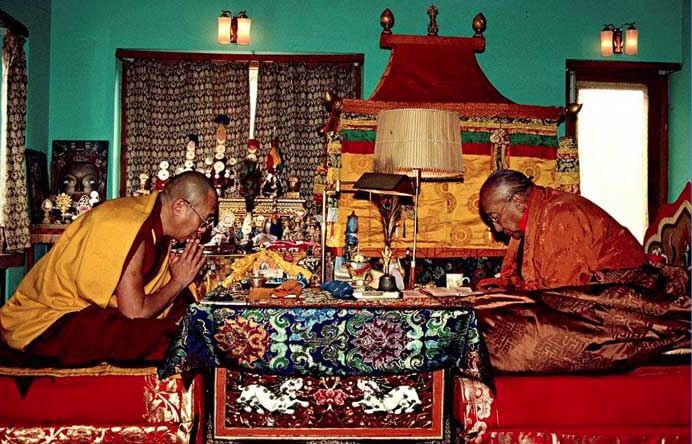

Another book exploring the student-teacher relationship is Alex Berzin’s Wise Teacher, Wise Student: Tibetan Approaches to a Healthy Relationship. The work covers many of the traditional topics but also gives a lot of thought to contemporary issues, cultural differences, and Westerner-specific issues like paranoia and vulnerability. He brings in some models from psychology (transference and regression) to explain many of the dynamics Westerners may present and how students can overcome them.

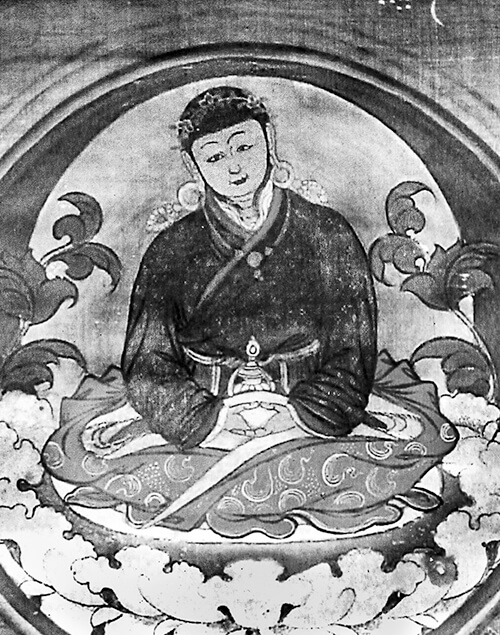
In general, although it is taught that there are six kinds of masters from whom you receive instruction, the masters who give the pith instructions are your root spiritual masters imbued with threefold kindness. Thus, no discourse or tantra relates a story of the attainment of enlightenment without that individual having relied upon a spiritual master. Each and every one of the highly accomplished masters who appeared in the past relied on material or nonmaterial spiritual masters, and developed all the qualities gained along the paths and stages of awakening; this is a matter of record. Therefore, your lamas have exhausted any flaws and have perfected all qualities: your lamas are the Buddha incarnate. Yet the mind-streams of us ordinary individuals are easily influenced by such things as conditions in our country, our historical period, or our companions. We must thus begin by examining spiritual masters from vantage points both close by and distant, then rely on them having set aside our negative thoughts or attitudes. In the end, having offered service by pleasing the lamas in three ways, and having kept tantric bonds without allowing them to be violated, we train so that our lamas’ wisdom mind and conduct are impressed upon us: our mind and conduct become like a clay image [satsa] emerging from a mold. This is very important.

Dudjom Rinpoche, mentioned above and one of the greatest masters of the 20th century, starts off his magisterial explanation of the foundational practices—A Torch Lighting the Way to Freedom: Complete Instructions on the Preliminary Practices, for those embarking on the path of Vajrayana Buddhism—with a long chapter titled “The Qualifications of Masters.”
He concludes it with:
Sublime teachers who are rid of all the faults just described and who possess all the right qualities are, because of the times, very hard to find—like the udumbara, the king of flowers. Even if they should happen to come across such teachers for just a little while, sentient beings with impure perception see faults in them—as has happened many times, starting with Devadatta who saw faults in the Bhagavan. Moreover, most people nowadays have the same store of negative deeds and misfortune, and so they perceive faults as good qualities and good qualities as faults. They see even those who have not a single ability that accords with the Dharma, whether manifest or hidden, as sublime beings, and so on. Those who know how to check are rare indeed. In particular, with regard to giving the profound teachings on the actual condition of things, teachers who have no realization cannot make the ultimate experience and realization develop in their disciples’ mindstreams. We should therefore take this point as a basis and regard a teacher who has most of the right qualities as the equal of the Buddha. The reason for considering even those in whom six of the above sets of qualities are complete and who have most of the right qualities as sublime beings and for following them is described in the Approach to the Absolute Truth:
Because of the age of strife, teachers have a mixture of faults and virtues:
There are none with no negative aspects at all.
Having carefully checked those who have more qualities,
Disciples should put their trust in them.
A Torch Lighting the Way to Freedom
$34.95 - Paperback
On Guru Yoga

Whether our teachers present in person are ordinary beings or emanations of Buddhas or Bodhisattvas, if we are able to pray to them considering them as the Buddha, there is absolutely no difference between them and the Buddha or Bodhisattva or yidam deity in person, because the source of blessings is devotion. So whichever profound practice we are undertaking, whether the generation phase or the perfection phase, we should begin by making the teacher’s blessings the path. There is no more to it than that. But as long as we have not received the blessings, we will not be genuinely on the path. It is said that if disciples who keep the commitments give themselves wholeheartedly, with devotion, to an authentic diamond master, they will obtain the supreme and common accomplishments even if they have no other methods. But without devotion to the teacher, even if we complete the approach and accomplishment practices of the yidams of the six tantra sections, we will never obtain the supreme accomplishment. And we will be unlikely to accomplish many of the ordinary accomplishments either, such as those of long life, wealth, or bringing beings under one’s power. Even if we do manage to achieve a little, it will have necessitated a lot of hardship and will have nothing to do with the profound path. When unmistaken devotion takes birth in us, obstacles on the path will be dispelled and we will make progress, obtaining all the supreme and ordinary accomplishments without depending on anything else. This is what we mean by the profound path of Guru Yoga.
A Torch Lighting the Way to Freedom
$34.95 - Paperback

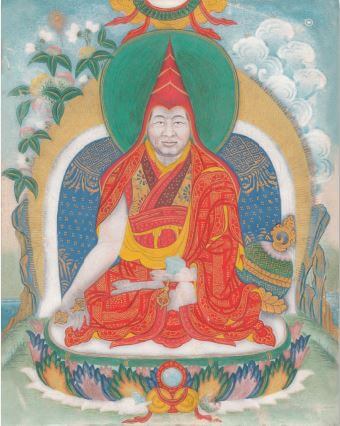
“There is one single criterion you should particularly check when examining a teacher: it is whether he has bodhichitta. If he has the bodhichitta, whatever sort of connection one makes with him will be meaningful. A good connection will bring buddhahood in one lifetime, and even a negative connection will eventually bring samsaric existence to an end.”
While one may not be so confident in their bodhicitta detection skills, the point is, after studying and analyzing the teacher, to use your own judgement.
If you wanted more detail, the author presents a more descriptive list of what characteristics to look for.
There are many other traditional overviews that include key instructions for evaluating, committing to, and following a teacher. From the tradition His Holiness the Dalai Lama was first educated in, Tsongkahpa’s The Great Treatise on the Stages of the Path to Enlightenment covers the subject over several pages. The great 18th-century adept Jigme Lingpa’s Treasury of Precious Qualities beautifully covers this as well.
A Guide to The Words of My Perfect Teacher
$34.95 - Paperback


- How to Seek the Wisdom Teacher
- The Justification for Following the Wisdom Teacher
- Categories and Characteristics of the Master Who Should Be Followed
- The Way in Which One Enters into and Goes Astray—Which Follows from the Characteristics of the Master
- The Characteristics of the Student Who Follows
- How to Follow
- The Necessity of Following the Wisdom Teacher in That Way
- Avoiding Contrary, Harmful Companions
- Creating Faith as a Favorable Condition
- The Way That the Wisdom Teacher Should Explain and the Student Should Listen to the Holy Dharma
Kongtrul relies on sutra and tantra sources to explain each of these. The reader will put it down having a much better appreciation for the scope of the Vajra master and student’s responsibilities, neither of which can be taken lightly.
The Teacher-Student Relationship
$24.95 - Paperback
By: Jamgon Kongtrul Lodro Taye & Ron Garry & Ven. Gyatrul Rinpoche & Lama Tharchin

Dangerous Friend: The Teacher-Student Relationship in Vajrayana Buddhism by Rig’dzin Dorje focuses exclusively on the Vajrayana aspects of the teacher-student relationship.


Many people are suspicious of Buddhism in general and particularly of the Vajrayana because of the intensity of the guru-disciple relationship. They are made uncomfortable by the level of projections that occur in the interaction of teacher and student. They do not like the lack of explicit restrictions, rules, and limitations on the relationship. They would prefer clear expectations and boundaries, without the uncertainty and intimacy that Vajrayana Buddhism implies.
Without denying the dangers in this as in all other intimate human relationships, and acknowledging that there can be no complete guarantee against mistakes and abuses, still there would appear something shortsighted in this point of view. As long as human beings live in the realm of samsaric duality, there is the inevitability of projection—in this case the positive projections of seeing something ‘‘out there’’ to which we are attracted and that we feel we need. What is sometimes not sufficiently realized is that no human beings are outside of this cycle.
Moreover, projection of this nature is not an inherently bad or undesirable thing. In fact, it is only because we are willing to project, willing to seek our dreams, that we can come up short and begin to integrate the part of ourselves that we had at first seen as outside. People do get ‘‘stuck,’’ but usually not forever. This process always involves vulnerability and suffering, but only in a culture that abhors pain and equates it with evil can one fail to see the transformative element.
The Vajrayana operates by eliciting and provoking the projections of our own deepest nature, then forcing us back on ourselves so that we have to integrate and take possession of those projections. This process is seen no more clearly than in the relation of teacher and student that forms the backbone of the path. Trungpa Rinpoche comments that at the beginning of the path, the teacher is seen virtually as a demigod. In the middle, he is experienced as a friend and companion. And at the end, when we have attained the state of realization that we once saw uniquely in him, he becomes inseparable from the inborn, living wisdom within.
What is sad is not to see this process of projection in Buddhism, where it can lead to something dignified and noble, but to see the way that it operates in the contemporary ‘‘modern’’ world, where it so often leads to an utter dead end. Here, people project their deepest yearnings onto things that have little to do with the human spirit and its maturation—new cars, upscale houses, clothes, vacations, credentials, fame, wealth, and power. It is not surprising, for example, that it is often among those who have succeeded most fully in realizing the materialism of the American Dream that one can find the most emptiness, fear, and unacknowledged despair.
Additional Resources
Another way to approach this is simply to read the stories of great masters and be inspired by their example. Here are a few places to get started:
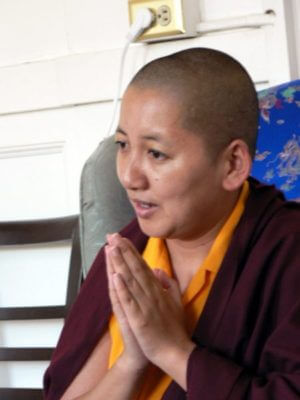
Khandro Rinpoche
Khandro Rinpoche discusses her teachers in her expansive Refuge chapter in This Precious Life: Tibetan Buddhist Teachings on the Path to Enlightenment
The incomparable lamas of the Longchen Nyintig tradition are presented in Tulku Thondup’s Masters of Meditation and Miracles.
The inspiring stories of Patrul Rinpoche are the subject of Matthieu Ricard’s collection of the oral history of this essential figure, Enlightened Vagabond.
The archetype of students, Milarepa, can be read about in many of the books included in our Reader’s Guide on him.
A subsequent article will address the related topic of Guru Yoga, which lies at the heart of the Vajrayana.
The Importance of the Ornament of Mahayana Sutras
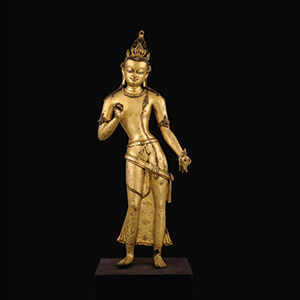
So just what is this text which is quoted everywhere but few have read?
Mipham Rinpoche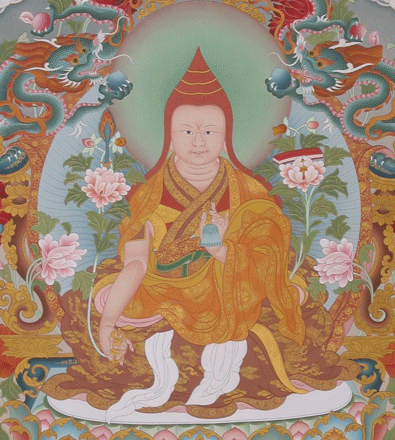 , paraphrasing Asanga's brother Vasubandu's student Sthiramati, says that this text:
, paraphrasing Asanga's brother Vasubandu's student Sthiramati, says that this text:
. . .explains all the profound and extensive practices of the bodhisattvas, which can be summarized under three headings: what to train in, how to train, and who is training.
The first of these, what one trains in, can be condensed into seven objects in which one trains: one’s own welfare, others’ welfare, thatness, powers, bringing one’s own buddha qualities to maturity, bringing others to maturity, and unsurpassable perfect enlightenment.
How one trains is in six ways: by first developing a great interest in the teachings of the Great Vehicle, investigating the Dharma, teaching the Dharma, practicing the Dharma in accord with the teachings, persevering in the correct instructions and follow-up teachings, and imbuing one’s physical, verbal, and mental activities with skillful means.
Those who train are the bodhisattvas, of whom there are ten categories: those who are of the bodhisattva type, those who have entered the Great Vehicle, those with impure aspirations, those with pure aspirations, those whose aspirations are not matured, those whose aspirations are matured, those with uncertain realization, those with certain realization, those who are delayed by a single birth, and those who are in their last existence.
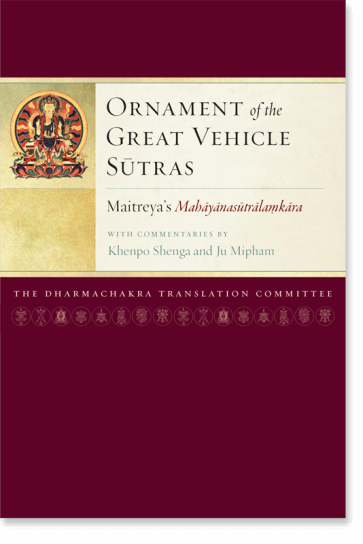
We have two translations of this text which both include the extensive and illuminating commentary by Mipham Rinpoche who based his long work on Sthiramati's famous commentary.
The first, The Ornament of the Great Vehicle Sutras, was translated by the Dharmachakra Translation Committee includes the annotations by Khenpo Shenga, who derived them often directly from Vasubandu's commentary. You can read our interview with Dharmachakra's Thomas Doctor which includes a short discussion of this text.
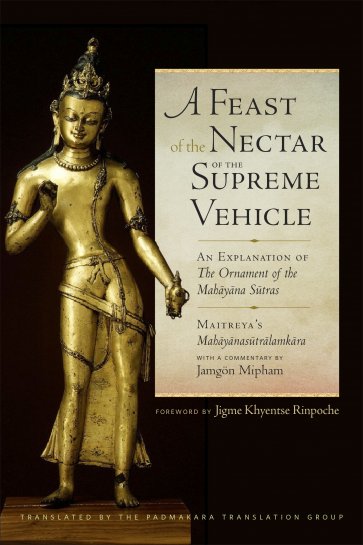
Here is the translator from Padmakara, Stephen Gethin, explaining the text.
It is hard to exaggerate the importance of this text in the Tibetan tradition. It was first translated from Sanskrit to Tibetan in the 8th century, at the time of Padmsambhava’s residence, by his disciple Kawa Peltsek. Atisha later taught it when he came to Tibet and refers to it repeatedly throughout his works. Gampopa references it in his Jewel Ornament of Liberation. The great Sakya master Ngorchen Konchog Lhundrub refers to it repeatedly in his Three Visions: Fundamental Teachings of the Sakya Lineage of Tibetan Buddhism. Virtually all the great masters of all the Tibetan traditions studied this work and its commentaries in depth.
In short, the Sutralamkara has been central to the training of hundreds of thousands of practitioners and scholars and remains today a core component of all the curriculums in monasteries and shedras.
A Feast of the Nectar of the Supreme Vehicle
$69.95 - Hardcover
By: Asanga & Jamgon Mipham & Maitreya & Padmakara Translation Group
Ornament of the Great Vehicle Sutras
$69.95 - Hardcover
By: Dharmachakra Translation Committee & Asanga & Jamgon Mipham & Maitreya & Khenpo Shenga
Below are a few more examples showing just how fundamental it is and some ways it is used in later Buddhist literature. And these are a small sampling—this text appears everywhere.
Jamgön Kongtrül brings it forth in his 10 volume Treasury of Knowledge. As an example, in Book Eight he relates how it is a core part of the Kadampa tradition, particularly the training in meditation. He then traces its lineage from Atisha's disciple Drontompa to Potawa to Langri Tampa and onwards to Tsongkhapa and into the present-day Gelug curriculum. He also uses it to prove the validity of the Mahayana.
Tsongkhapa and into the present-day Gelug curriculum. He also uses it to prove the validity of the Mahayana.

The Treasury of Knowledge: Book Eight, Part Four
$59.95 - Hardcover
Longchenpa refers to it throughout his works as pointed out repeatedly in Tulku Thondup's The Practice of Dzogchen. It appears also in the recent translation of Longchenpa's Finding Rest trilogy.
Dudjom Rinpoche brings it into his History of the Nyingma School throughout The Nyingma School of Tibetan Buddhism, in which he calls it the text that teaches “the integration of conduct and view.” He also refers to it repeatedly in A Torch Lighting the Way to Freedom when he is explaining the nature of the six perfections.
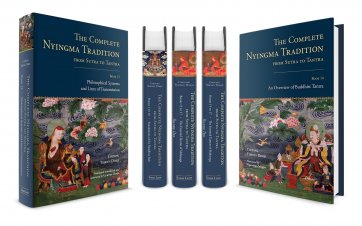
A Torch Lighting the Way to Freedom
$34.95 - Paperback
In Brilliant Moon, Dilgo Khyentse Rinpoche relates how he and his brother received the instructions on the text. He also brings it up repeatedly in Heart of Compassion, his discussion of the 37 Practices of a Bodhisattva; the power and strength of love; the perfection of wisdom; and the role emotions play to "destroy oneself, destroy others, and destroy discipline." He also mentions it in his biography of Jamyang Khyentse Chökyi Lodrö, using phrases describing the nature of bodhisattvas to show how the latter was one.
In his commentary on the 9th chapter of The Way of the Bodhisattva that appears in The Center of the Sunlit Sky, the great Kagyu master Pawo Rinpoche—the student of the 8th Karmapa and teacher to the 9th—devotes thirteen pages to the Sutralamkara explaining how the text proves the validity and authenticity of the Mahayana.
$39.95 - Paperback
By: H.H. the Fourteenth Dalai Lama & Dilgo Khyentse Rinpoche & Ani Jinba Palmo & Shechen Rabjam
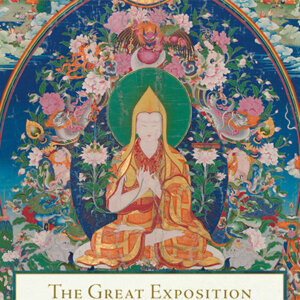
Tsongkhapa: A Guide to His Life and Works

The Life of Tsongkhapa Lobsang Drakpa (1357-1419)
Tsongkhapa Lobzang Drakpa (1357–1419), was one of the most important figures in Tibet, historically and philosophically. As the founder of the Gelug school he made an enormous contribution to revitalizing Buddhism in Tibet. Regarded as an emanation of Manjushri--the bodhisattva of wisdom and discerning intelligence, Tsongkhapa was of keen intellect as well as experiential understanding of the Buddhist tradition. He undertook many long retreats during which he had profound visions out of which he wrote many of his celebrated treatises including Lam Rim Chenmo or The Great Exposition of the Stages of the Path. A prolific writer, he composed 210 treatises, compiled into 20 volumes wherein he emphasized the combined paths of Sutra and Tanta. In addition, he established the acclaimed Ganden monastery.
For a longer biography of Tsongkhapa read an excerpt from Geshe Sonam Rinchen's commentary on The Three Principal Aspects of the Path.
"Born in 1357 in Amdo, northeastern Tibet, and educated in central Tibet, Tsongkhapa led a life that exemplified the importance of study, critical reflection, and meditative practice. In an autobiographical poem he declared:
"First I sought wide and extensive learning,
Second I perceived all teachings as personal instructions,
Finally, I engaged in meditative practice day and night;
All these I dedicated to the flourishing of the Buddha’s teaching.By the end of his life, 600 years ago, Tsongkhapa was widely revered across Tibet. He had studied and corresponded with the most renowned teachers of his time, from all the major traditions, and had spent years in meditative retreat."
—From the Foreward by H. H. The Dalai Lama, Tsongkhapa: A Buddha in the Land of Snows, by Thupten Jinpa
The Definitive Biography of Tsongkhapa
Paperback | Ebook
$29.95 - Paperback
Marking the 600th anniversary of Tsongkhapa, in 2019 we published what is the most comprehensive, definitive biography of this great figure, written by Thupten Jinpa. The author is best known as the main translator for the Dalai Lama, but he is an author and scholar himself, having earned a Geshe degree. In the author’s words,
this new biography of Tsongkhapa…is aimed primarily at the contemporary reader. And it seeks to answer the following key questions for them: ‘Who was or is Tsongkhapa? What is he to Tibetan Buddhism? How did he come to assume the deified status he continues to enjoy for the dominant Geluk School of Tibetan Buddhism? What relevance, if any, do Tsongkhapa’s thought and legacy have for our contemporary thought and culture?
—Thupten Jinpa, from the Introduction to Tsongkhapa: A Buddha in the Land of Snows
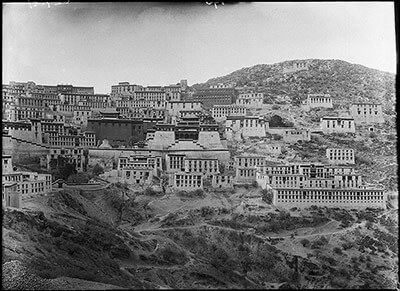
Ganden monastery, founded by Tsongkhapa, photographed in 1921 by Sir Charles Bell
Whoever sees or hears
Or contemplates these prayers,
May they never be discouraged
In seeking the bodhisattva’s amazing aspirations.
By praying with such expansive thought
Created from the power of pure intention,
May I achieve the perfection of prayers
And fulfill the wishes of all sentient beings.
Tsongkhapa's Lam Rim Chenmo, The Great Treatise on the Stages of the Path to Enlightenment
Tsongkhapa's main contribution to this genre is the famous Lamrim Chenmo or The Great Treatise on the Stages of the Path to Enlightenment. It is also generally considered his most influential work, studied and practiced by tens of thousands today.
The background to this work is on one of Tsongkhapa’s own letters to a lama, included in Art Engle's The Inner Science of Buddhist Practice, where he describes it as building on Atisha’s Lamp for the Path to Enlightenment:
“It is clear that this instruction [introduced] by [Atisha] Dīpaṃkara Śrījnāna on the stages of the path to enlightenment . . . teaches [the meanings contained in] all the canonical scriptures, their commentaries, and related instruction by combining them into a single graded path. One can see that when taught by a capable teacher and put into practice by able listeners it brings order, not just to some minor instruction, but to the entire [body of] canonical scriptures. Therefore, I have not taught a wide variety of [other] instructions.”
Paperback | Ebook
$19.95 - Paperback
The Great Treatise on the Stages of the Path to Enlightenment (Vol. 1-3)
The Great Treatise on the Stages of the Path to Enlightenment (Tib. Lam rim chen mo) is one of the brightest jewels in the world’s treasury of sacred literature. The author, Tsong-kha-pa, completed it in 1402, and it soon became one of the most renowned works of spiritual practice and philosophy in the world of Tibetan Buddhism. Because it condenses all the exoteric sūtra scriptures into a meditation manual that is easy to understand, scholars and practitioners rely on its authoritative presentation as a gateway that leads to a full understanding of the Buddha’s teachings.
Tsong-kha-pa took great pains to base his insights on classical Indian Buddhist literature, illustrating his points with classical citations as well as with sayings of the masters of the earlier Kadampa tradition. In this way the text demonstrates clearly how Tibetan Buddhism carefully preserved and developed the Indian Buddhist traditions.
Paperback| Ebook
$34.95 - Paperback
(Volume 1)
By Tsongkhapa
Edited by Joshua Cutler and Guy Newland, Translated by Lamrim Chenmo Translation Committee
This first of three volumes covers all the practices that are prerequisite for developing the spirit of enlightenment (bodhicitta).
Paperback| Ebook
$28.95 - Paperback
(Volume 2)
By Tsongkhapa
Edited by Joshua Cutler and Guy Newland, Translated by Lamrim Chenmo Translation Committee
This second of three volumes covers the deeds of the bodhisattvas, as well as how to train in the six perfections.
Paperback| Ebook
$34.95 - Paperback
(Volume 3)
By Tsongkhapa
Edited by Joshua Cutler and Guy Newland, Translated by Lamrim Chenmo Translation Committee
This third and final volume contains a presentation of the two most important topics in the work: meditative serenity (śamatha) and supramundane insight into the nature of reality (vipaśyanā).
Commentaries on Tsongkhapa's Great Treatise and other Lam Rim (Stages of the Path) texts
"The Great Treatise was written by Lama Tsong-kha-pa, a great scholar, a real holder of the Nalanda tradition. I think he is one of the very best Tibetan scholars. Although it is now widely available in Tibetan as well as English, you see that I brought with me today my own personal copy of this text. On March 17th, 1959, when I left Norbulingka that night, I brought this book with me. Since then I have used it ten or fifteen times to give teachings, all from this copy. So this is something very dear to me."
-H.H The Dalai Lama discussing his copy of the Great Treatise in From Here to Enlightenment
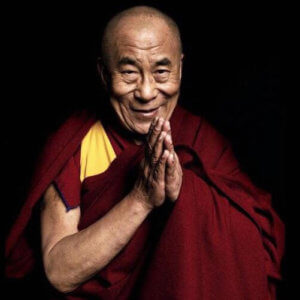
Paperback | Ebook
$19.95 - Paperback
From Here to Enlightenment
An Introduction to Tsong-kha-pa's Classic Text The Great Treatise on the Stages of the Path to Enlightenment
By H.H. The Dalai Lama and translated by Guy Newland
When the Dalai Lama was forced into exile in 1959, he could take only a few items with him. Among these cherished belongings was his copy of Tsong-kha-pa’s classic text The Great Treatise on the Stages of the Path to Enlightenment. This text distills all the essential points of Tibetan Buddhism, clearly unfolding the entire Buddhist path.
In 2008, celebrating the long-awaited completion of the English translation of the Great Treatise, the Dalai Lama gave a historic six-day teaching at Lehigh University to explain the meaning of the text and underscore its importance. It is the longest teaching he has ever given to Westerners on just one text—and the most comprehensive. From Here to Enlightenment makes the teachings from this momentous event available for a wider audience.
Paperback | Ebook
$21.95 - Paperback
Introduction to Emptiness
As Taught in Tsong-kha-pa's Great Treatise on the Stages of the Path
By Guy Newland
Readers are hard-pressed to find books that can help them understand the central concept in Mahayana Buddhism—the idea that ultimate reality is emptiness. In clear language, Introduction to Emptiness explains that emptiness is not a mystical sort of nothingness, but a specific truth that can and must be understood through calm and careful reflection. Newland's contemporary examples and vivid anecdotes will help readers understand this core concept as presented in one of the great classic texts of the Tibetan tradition, Tsong-kha-pa's Great Treatise on the Stages of the Path to Enlightenment. This new edition includes quintessential points for each chapter.
Paperback | Ebook
$17.95 - Paperback
Refining Gold
Stages in Buddhist Contemplative Practice
By H.H. The Dalai Lama
In this extensive teaching, the Dalai Lama beautifully elucidates the meaning of the path to enlightenment through his own direct spiritual advice and personal reflections. Based on two very famous Tibetan text—Tsongkhapa's Song of the Stages on the Spiritual Path and the Third Dalai Lama's Essence of Refined Gold—this teaching presents in practical terms the essential instructions for the attainment of enlightenment. Its direct approach and lucid style make Refining Gold one of the most accessible introductions to Tibetan Buddhism ever published. His discourse draws out the meaning of the Third Dalai Lama’s famous Essence of Refined Gold as he speaks directly to the reader, offering advice, personal reflections, and scriptural commentary. He says in practical terms what the student must do to attain enlightenment.
Tsongkhapa's Three Principle Aspects of the Path
This is the shortest Lamrim text Tsongkhapa composed. Tsongkhapa wrote the fourteen stanzas of this classic distillation of all the paths of practice that lead to enlightenment. The three principal elements of the path referred to are: (1) renunciation, tied to the wish for freedom from cyclic existence; (2) the motivation to attain enlightenment for the benefit of others; (3) cultivating the correct view that realizes emptiness.
Paperback | eBook
$21.95 - Paperback
Three Principal Aspects of the Path
By Geshe Sonam Rinchen, edited and translated by Ruth Sonam
The wish for freedom, the altruistic intention, and the wisdom realizing emptiness constitute the essence of the Buddhist path. In this teaching, Geshe Sonam Rinchen explains, in clear and readily accessible terms, Je Tsongkhapa’s (1357–1419) famed presentation of these three essential topics.
The Three Principal Aspects is also included in Cutting Through Appearances: Practice and Theory of Tibetan Buddhism in which Geshe Sopa annotates the Fourth Panchen Lama’s instructions on how to practice this text in a meditation session.
His Holiness the Dalai Lama teaches on this text, and this is included as the chapter “The Path to Enlightenment” in Kindness, Clarity, and Insight.
Paperback | Ebook
$39.95 - Paperback
Paperback | Ebook
$16.95 - Paperback
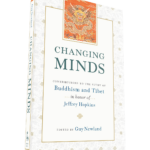
Paperback | eBook
$29.95 - Paperback
Another work where Tsongkhapa’s Lamrim is featured is in Changing Minds: Contributions to the Study of Buddhism and Tibet in Honor of Jeffrey Hopkins. There are three chapters devoted to Tsongkhapa:
- Guy Newland’s Ask a Farmer: Ultimate Analysis and Conventional Existence in Tsongkhapa’s Lam Rim Chen Mo
- Daniel Cozort’s Cutting the Roots of Virtue: Tsongkhapa on the Results of Anger
- Elizabeth Napper’s Ethics as the Basis of a Tantric Tradition: Tsongkhapa and the Founding of the Gelugpa Order
Lotsawa House also includes a translation of these fourteen stanzas.
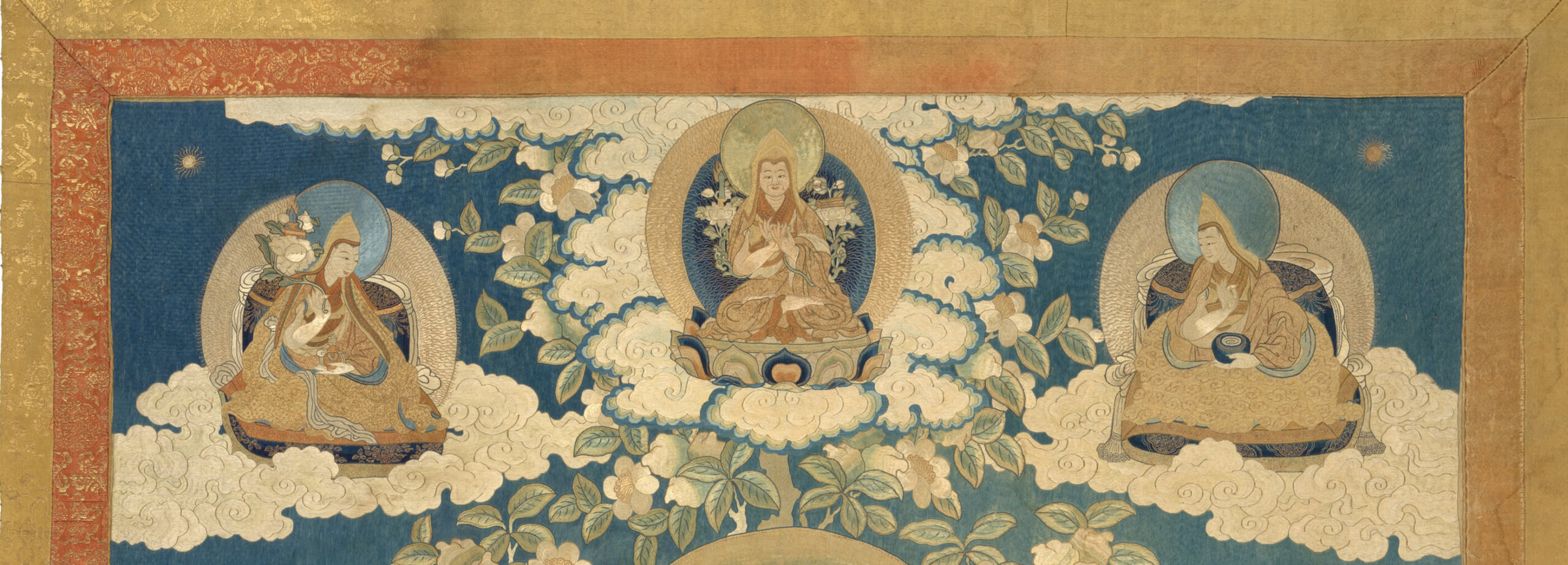
Tsongkhapa on Madhyamaka, The Middle Way School
Tsongkhapa is known for his distinct approach to the middle way philosophical system (madhyamaka) propounded by Indian masters Nāgārjuna (circa 200 CE) and Candrakīrti (circa 600 CE).
"I first went to India in 1972 on a dissertation research Fulbright fellow-ship, where although advised by the Fulbright Commission in New Delhi not to go to Dharmsala because of possible political complications, I went after a brief trip to Banaras. There I found that the Dalai Lama was about to begin a sixteen-day series of four- to six-hour lectures on Tsong-kha-pa Lo-sang-drak-pa’s Medium-Length Exposition of the Stages of the Path to Enlightenment Practiced by Persons of Three Capacities. Despite my cynicism that a governmentally appointed reincarnation could possibly have much to offer, I slowly became fascinated first with the strength and speed of his articulation and then, much more so, with the touching meanings that were conveyed."
-Jeffrey Hopkins, from the Preface to Tsong-kha-pa's Final Exposition of Wisdom

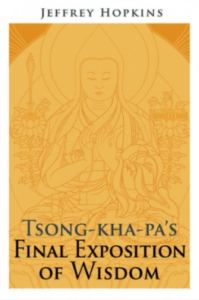
Paperback | eBook
$44.95 - Paperback
Tsong-kha-pa's Final Exposition of Wisdom
By Jeffrey Hopkins
In fourteenth- and fifteenth-century Tibet there was great ferment about what makes enlightenment possible, since systems of self-liberation must show what factors pre-exist in the mind that allow for transformation into a state of freedom from suffering. This controversy about the nature of mind, which persists to the present day, raises many questions. This book first presents the final exposition of special insight by Tsong-kha-pa, the founder of the Ge-luk-pa order of Tibetan Buddhism, in his medium-length Exposition of the Stages of the Path as well as the sections on the object of negation and on the two truths in his Illumination of the Thought: Extensive Explanation of Chandrakirti's Supplement to Nagarjuna's "Treatise on the Middle." It then details the views of his predecessor Dol-po-pa Shay-rap Gyel-tsen, the seminal author of philosophical treatises of the Jo-nang-pa order, as found in his Mountain Doctrine, followed by an analysis of Tsong-kha-pa's reactions. By contrasting the two systems—Dol-po-pa's doctrine of other-emptiness and Tsong-kha-pa's doctrine of self-emptiness—both views emerge more clearly, contributing to a fuller picture of reality as viewed in Tibetan Buddhism. Tsong-kha-pa's Final Exposition of Wisdom brilliantly explicates ignorance and wisdom, explains the relationship between dependent-arising and emptiness, shows how to meditate on emptiness, and explains what it means to view phenomena as like illusions.
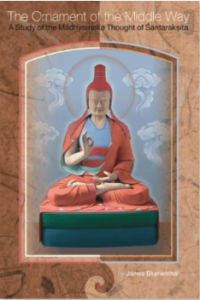
Paperback
$34.95 - Paperback
The Ornament of the Middle Way
A Study of the Madhyamaka Thought of Santaraksita
By James Blumenthal
The late James Blumenthal explores this important text by Shantarakshita and brings in Tsongkhapa’s text on this subject.
Shantarakshita's The Ornament of the Middle Way is among the most important Mahayana Buddhist philosophical treatises to emerge on the Indian subcontinent. In many respects, it represents the culmination of more than 1300 years of philosophical dialogue and inquiry since the time of the historical Buddha Shakyamuni. Shantarakshita set forth the foundation of a syncretic approach to contemporary ideas by synthesizing the three major trends in Indian Buddhist thought at the time (the Madhyamaka thought of Nagarjuna, the Yogachara thought of Asanga, and the logical and epistemological thought of Dharmakirti) into one consistent and coherent system. Shantarakshitas's text is considered to be the quintessential exposition or root text of the school of Buddhist philosophical thought known in Tibet as Yogachara-Svatantrika-Madhyamaka. In addition to examining his ideas in their Indian context, this study examines the way Shantarakshita's ideas have been understood by and have been an influence on Tibetan Buddhist traditions. Specifically, Blumenthal examines the way scholars from the Geluk School of Tibetan Buddhism have interpreted, represented, and incorporated Santaraksita's ideas into their own philosophical project. This is the first book-length study of the Madyamaka thought of Shantarakshita in any Western language. It includes a new translation of Shantarakshita's treatise, extensive extracts from his autocommentary, and the first complete translation of the primary Geluk commentary on Shantarakshita's treatise.
"As a religious reformer, he has been likened to Luther by Western Buddhologists; but as a religious scholar he is regarded in his own culture as a genius whose statue more closely parallels that of Aquinas in Western Christianity. For Tsongkhapa created his own unique interpretation of Buddhist systematics and hermeneutics, in which he synthesized themes from all the Tibetan Buddhist traditions of his era. For these reasons he was praised by the Eight Karmapa as Tibet's chief exponent of ultimate truth, who revived the Buddha's doctrine at a time when the teachings of all four major Tibetan Buddhist lineages were in decline."
-B. Alan Wallace, from the Preface to Balancing the Mind
Paperback | eBook
$24.95 - Paperback
Balancing the Mind
A Tibetan Buddhist Approach to Refining Attention
By B. Alan Wallace
For centuries, Tibetan Buddhist contemplatives have directly explored consciousness through carefully honed and rigorous techniques of meditation. B. Alan Wallace explains the methods and experiences of Tibetan practitioners and compares these with investigations of consciousness by Western scientists and philosophers. Balancing the Mind includes a translation of the classic discussion of methods for developing exceptionally high degrees of attentional stability and clarity by fifteenth-century Tibetan contemplative Tsongkhapa.
Tsongkhapa and the Debate over the Two Truths
Tsongkhapa is famous—and in some circles controversial—for his presentation and positioning of the Prasangika view of Madhyamaka. Any discussion or debate of this subject invariably references Tsongkhapa.
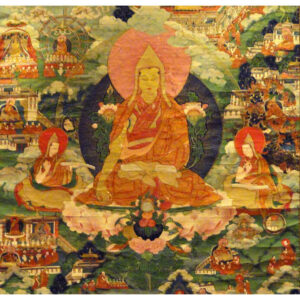
Hardcover | eBook
$78.00 - Hardcover
The Center of a Sunlight Sky
Madhyamaka in the Kagyu Tradition
By Karl Brunnhölzl
This comprehensive work by Karl Brunnholzl explores all facets of Madhyamaka in the Kagyu tradition, but no analysis of Madhyamaka can leave out Tsongkhapa who appears throughout this work. There is a sixty-page section comparing the views of Tsongkhapa to those of Mikyo Dorje’s “whose writing, not only is a reaction to the position of Tsongkhapa and his followers but addresses most of the views on Madhyamaka that were current in Tibet at the time, including the controversial issue of ‘Shentong-Madhyamaka.’”
Paperback| eBook
$39.95 - Paperback
The Adornment of the Middle Way
Shantarakshita's Madhyamakalankara with Commentary by Jamgon Mipham
By Jamgon Mipham, translated by Padmakara Translation Group
For a different take on Shantarakshita's The Ornament of the Middle Way (same text, differently translated title) The Adornment of the Middle Way translated by the Padmakara Translation Group, gives a helpful introduction on the various interpretations. This longer passage offers a glimpse into some of the fault lines in the debate:
"The brilliance of Tsongkhapa’s teaching, his qualities as a leader, his emphasis on monastic discipline, and the purity of his example attracted an immense following. Admiration, however, was not unanimous, and his presentation of Madhyamaka in particular provoked a fierce backlash, mainly from the Sakya school, to which Tsongkhapa and his early disciples originally belonged. These critics included Tsongkhapa’s contemporaries Rongtön Shakya Gyaltsen (1367–1449) and Taktsang Lotsawa (1405–?), followed in the next two generations by Gorampa Sonam Senge (1429–1487), Serdog Panchen Shakya Chokden (1428–1509), and the eighth Karmapa, Mikyö Dorje (1505–1557). All of them rejected Tsongkhapa’s interpretation as inadequate, newfangled, and unsupported by tradition. Although they recognized certain differences between the Prasangika and Svatantrika approaches, they considered that Tsongkhapa had greatly exaggerated the divergence of view. They believed that the difference between the two subschools was largely a question of methodology and did not amount to a disagreement on ontological matters.
Not surprisingly, these objections provoked a counterattack, and they were vigorously refuted by Tsongkhapa’s disciples. In due course, however, the most effective means of silencing such criticisms came with the ideological proscriptions imposed at the beginning of the seventeenth century. These followed the military intervention of Gusri Khan, who put an end to the civil war in central Tibet, placed temporal authority in the hands of the Fifth Dalai Lama, and ensured the rise to political power of the Gelugpa school. Subsequently, the writings of all the most strident of Tsongkhapa’s critics ceased to be available and were almost lost. It was, for example, only at the beginning of the twentieth century that Gorampa’s works could be fully reassembled, whereas Shakya Chokden’s works, long thought to be irretrievably lost, were discovered only recently in Bhutan and published as late as 1975."
-from the Introduction to The Adornment of the Middle Way
The Wisdom Chapter
Jamgön Mipham's Commentary on the Ninth Chapter of The Way of the Bodhisattva
By Jamgon Mipham, translated by Padmakara Translation Group
This work on the Wisdom Chapter of Shantideva’s classic, written more than four centuries after Tsongkhapa, is a presentation of a different view than that expounded by Tsongkhapa. It is, in fact, a superb source for understanding the impact of his Madhyamaka presentation in a wider context, historically and philosophically. The extensive introduction gives a very complete and comprehensive account. In sum:
"In his treatment of the Gelugpa account, Mipham concurs in all important respects with Gorampa and the rest of Tsongkhapa’s earlier critics. Indeed, his critique is possibly even more effective in being expressed moderately and without vituperation. Nevertheless, he is careful never to attack Tsongkhapa personally. Given the fact that Mipham was a convinced upholder of the nonsectarian movement, there is no reason to doubt the sincerity of the humble and respectful manner with which he invariably refers to Tsongkhapa. No sarcasm is detectable in his words:
In the snowy land of Tibet, the great and venerable lord Tsongkhapa was unrivaled in his activities for the sake of the Buddha’s teaching. And with regard to his writings, which are clear and excellently composed, I do indeed feel the greatest respect and gratitude.
There is, however, a striking contrast between Mipham’s veneration of Tsongkhapa, on the one hand, and his penetrating critique of his view, on the other. Mipham’s assessment seems to oscillate between an approbation of some of Tsongkhapa’s positions, regarded as unproblematic expressions of a Svātantrika approach that Mipham valued, and a determination to demolish Tsongkhapa’s philosophical innovations and their pretended Prāsaṅgika affiliations. This discrepancy has led some scholars to accuse Mipham of inconsistency. Closer scrutiny suggests, however, that Mipham’s admittedly complex attitude to Tsongkhapa was in point of fact quite coherent."
-from the Introduction to The Wisdom Chapter
Tsongkhapa's Poetry and Songs of Realization
Paperback
$22.95 - Paperback
Thupten Jinpa’s collection of Tibetan poetry includes two poems by Tsongkhapa including Reflections on Emptiness, which is extracted from a larger work, the rTag tu ngu’i rtogs brjod—a poetic retelling of the story of the bodhisattva Sadāprarudita, who is associated with the 8,000 Verse Prajnamaramita Sutra and A Prayer for the Flourishing of Virtues.
Jinpa presents Tsongkhapa’s poetry first in terms of his mastery of composition and second, in terms of his mastery of the Buddhist path.
First, describing his master of composition, Jinpa writes:
Tsongkhapa’s famous long poem entitled ‘‘A Literary Gem of Poetry’’ uses a single vowel in every stanza throughout the entire length. This is the poem from which come the famous lines:
Good and evil are but states of the heart:
When the heart is pure, all things are pure;
When the heart is tainted, all things are tainted.
So all things depend on your heart.In the original Tibetan, this stanza uses only the vowel a. Of course, this kind of literary device can never be reproduced in a translation, whatever the virtuosity and command of the translator.
Second, describing his mastery of the Buddhist path Jinpa states:
To a contemporary reader, Tsongkhapa’s famous ‘‘Prayer for the Flourishing of Virtues’’ gives an insight into the deepest ideals of a dedicated Tibetan Buddhist practitioner; it presents a map of progressive development on the path. Beyond this, the mystic must utterly transform the very root of his identity and the perceptions that arise from it. From the ordinary patterns of action and reaction that make up our psyche and emotional life, the meditator must move toward a divine state of altered consciousness where all realities, including one’s own self, are manifested in their enlightened forms. In other words, the meditator must perfect all dimensions of his or her identity and experience, including rationality, emotion, intuition, and even sexuality. This, in Tibetan Buddhism, is the mystical realm of tantra.
Tsongkhapa and Tantra
A brief note. For those unfamiliar or only exposed through books, we strongly encourage readers to study tantra under the guidance of a qualified teacher. Book reading can only take you so far as the transmission of tantric teaching is about more than what can be put on paper.
This work is analogous to the tantra version of the Lamrim Chenmo, presenting tantra from the position of the sarma, ie., the 'new school,' or later transmission from India.
There are three books by Tsongkhapa and His Holiness the Dalai Lama that form a series focused on Tsongkhapa's Great Exposition of Secret Mantra. In this text, Tsongkhapa presents the differences between sutra and tantra and the main features of various systems of tantra. Each of the three books below begins with the Dalai Lama contextualizing and commenting on the points presented in Tsongkhapa's text, followed by a translation of the corresponding part of the text itself.
Paperback
$29.95 - Paperback
In Volume 1: Tantra in Tibet, the foundations of motivation, refuge, and the Hinayana and Mahayana paths are presented. He then gives an overview of tantra, the notion of Clear Light, the greatness of mantra, and initiation or empowerment.
This revised work describes the differences between the Great Vehicle and Lesser Vehicle streams in the sutra tradition, and between the sutra tradition and that of tantra generally. It includes highly practical and compassionate explanations from H.H. the Dalai Lama on tantra for spiritual development; the first part of the classic Great Exposition of Secret Mantra text; and a supplement by Jeffrey Hopkins on the difference between the Vehicles, emptiness, psychological transformation, and the purpose of the four tantras.
Paperback
$29.95 - Paperback
In Volume II: Deity Yoga, His Holiness discusses deity yoga at length with a particular focus on action and performance tantras (the first two categories of tantra as described in the sarma, or “new translation” schools).
This revised work describes the profound process of meditation in Action (kriya) and Performance (carya) Tantras. Invaluable for anyone who is practicing or is interested in Buddhist tantra, this volume includes a lucid exposition of the meditative techniques of deity yoga from H.H. the Dalai Lama; the second and third chapters of the classic Great Exposition of Secret Mantra text; and a supplement by Jeffrey Hopkins outlining the structure of Action Tantra practices as well as the need for the development of special yogic powers.
Paperback
$27.95 - Paperback
in Volume III: Yoga Tantra the Dalai Lama details the practice of the next level of tantra, yoga tantra. With a preliminary overview of the motivation, His Holiness explains this level, which focuses on internal yoga, which here means the union of deity yoga with the wisdom of realizing emptiness. He details the yoga, both that with and that without signs, and then briefly explains how gaining stability in these practices is the foundation for some other practices that lead to mundane and extraordinary “feats.”
This work opens with the Dalai Lama presenting the key features of Yoga Tantra then continues with the root text by Tsongkhapa. This is followed by an overview of the central practices by Khaydrub Je. Jeffrey Hopkins concludes the volume with an outline of the steps of Yoga Tantra practice, which is drawn from the Dalai Lama’s, Tsongkhapa’s, and Khaydrub Je’s explanations.
An explanation of the highest yoga tantra is not included in these works, but an excellent resource is Daniel Cozort's Highest Yoga Tantra.
Paperback
$39.95 - Paperback
The Six Yogas of Naropa
Tsongkhapa's Commentary
By Glenn H. Mullin
Tsongkhapa's commentary entitled A Book of Three Inspirations: A Treatise on the Stages of Training in the Profound Path of Naro's Six Dharmas is commonly referred to as The Three Inspirations. Anyone who has read more than a few books on Tibetan Buddhism will have encountered references to the Six Yogas of Naropa, a preeminent yogic technology system. The six practices—inner heat, illusory body, clear light, consciousness transference, forceful projection, and bardo yoga—gradually came to pervade thousands of monasteries, nunneries, and hermitages throughout Central Asia over the past five and a half centuries.
Paperback
$27.95 - Paperback
The Practice of the Six Yogas of Naropa
By Glenn H. Mullin
Another text that is included in Tsongkhapa’s collected works is the short Practice Manual on the Six Yogas. This is included in the wider collection of texts on this practice titled The Practice of the Six Yogas of Naropa. Also included in this book are works by Tilopa, Naropa, Je Sherab Gyatso, and the First Panchen Lama.
From the Six Yogas of Naropa:
"Tsongkhapa's treatise on this system of tantric practice ... became the standard guide to the Naropa tradition at Ganden Monastery, the seat he founded near Lhasa in 1409. Ganden was to become the motherhouse of the Gelukpa school, and thus the symbolic head of the network of thousands of Gelukpa monasteries that sprang up over the succeeding centuries across Central Asia, from Siberia to northern India. A Book of Three Inspirations has served as the fundamental guide to Naropa's Six Yogas for the tens of thousands of Gelukpa monks, nuns, and lay practitioners throughout that vast area who were interested in pursuing the Naropa tradition as a personal tantric study. It has performed that function for almost six centuries now.
Tsongkhapa the Great's A Book of Three Inspirations has for centuries been regarded as special among the many. The text occupies a unique place in Tibetan tantric literature, for it in turn came to serve as the basis of hundreds of later treatments. His observations on various dimensions and implications of the Six Yogas became a launching pad for hundreds of later yogic writers, opening up new horizons on the practice and philosophy of the system. In particular, his work is treasured for its panoramic view of the Six Yogas, discussing each of the topics in relation to the bigger picture of tantric Buddhism, tracing each of the yogic practices to its source in an original tantra spoken by the Buddha, and presenting each within the context of the whole. His treatise is especially revered for the manner in which it discusses the first of the Six Yogas, that of the 'inner heat.' As His Holiness the present Dalai Lama put it at a public reading of and discourse upon the text in Dharamsala, India, in 1991, 'the work is regarded by Tibetans as tummo gyi gyalpo, the king of treatments on the inner heat yoga.' Few other Tibetan treatises match it in this respect."
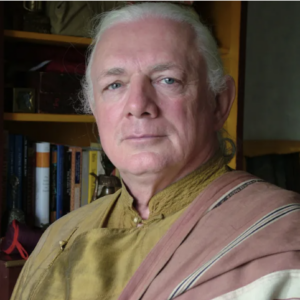
Paperback | eBook
$39.95 - Paperback
This work has three main sections: an overview of Mahamudra, the First Panchen’s text The Main Road of the Triumphant Ones, and a commentary by the Dalai Lama. The author contextualizes the selection saying that the tradition of Mahamudra in the Gelug tradition comes through Tsongkhapa.
Other Notable Works Related to Tsongkhapa
Paperback | eBook
$39.95 - Paperback
Tibetan Literature
Studies in Genre
Edited by Jose Cabezon and Roger R. Jackson
Tibetan Literature: Studies in Genre is a collection by leading Tibetologists. The immensity of Tibet's literary heritage, unsurprisingly, is filled with references to Tsongkhapa across a wide range of subjects. Just a sampling of them include: the establishment of the Gelug order; the monastic curriculum; debate manuals; establishment of Ganden; a comparison with Milarepa; the controversies about his views; a classification of his texts; and a lot more.
Paperback | eBook
$29.95 - Paperback
Mind in Tibetan Buddhism
By Lati Rinpoche, Edited and translated by Elizabeth Napper
Mind in Tibetan Buddhism is an oral commentary on Geshe Jampel Sampel's Presentation of Awareness and Knowledge Composite of All the Important Points, Opener of the Eye of New Intelligence. This topic, lorig in Tibetan, was not one on which Tsongkhapa wrote a dedicated text, but he does include it in an introduction to Dharmakirti’s Seven Treatises and one of his sections includes a brief presentation on lorig. Tsongkhapa is brought up throughout this book.
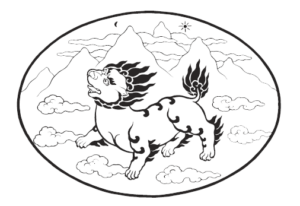
Tsongkhapa is also referenced in about 60 articles on shambhala.com, mostly from the Snow Lion newsletter archive.
Additional Resources


More can be found on Atisha's life on Treasury of Lives
SNOW LION NEWSLETTER ARCHIVE

The Dalai Lama: Reliance on a Teacher
This article on reliance on a teacher originally appeared in the Snow Lion newsletter, Vol 12 #4, Fall 1997
Answers to Questions at the Tibetan Buddhist Learning Center, Washington, New Jersey, September 1990
Joshua Cutler: Americans in general are very wary of relying on one person and giving that person a lot of power and control. This is difficult for American people. But on the other hand, I know that, when the teaching was coming from India to Tibet, Atisha was asked by Dromtonpa, "How is it that we Tibetans have such a good knowledge of the teachings yet no one has produced any of the realizations of the grounds and the paths?" Atisha replied that it was because Tibetans were still viewing the teacher as an ordinary person. It’s very clear to me that this teaching of faith in the spiritual teacher is the very foundation of the teaching being able to grow in this country, but there is a problem because many spiritual teachers have abused their students and so people are very suspicious of teachers. Could Your Holiness please give us guidance on this practice of relying upon the spiritual teacher?
Related Books
Atisha's Lamp for the Path to Enlightenment
$19.95 - Paperback
By: Atisha & Geshe Sonam Rinchen & Ruth Sonam
His Holiness the Dalai Lama: Atisha explicitly mentions that all the Great Vehicle realizations, be they great or small, depend on proper reliance upon a spiritual teacher. He then says that as the Tibetans view their lamas as only ordinary persons, they are not attaining realizations. His advice applies to Great Vehicle realizations.
But in giving a general explanation of Buddha’s doctrine, we have to include both the Great and Hearer Vehicles. Therefore, take for example the solitary realizers. In Maitreya’s Abhisamayalamkara, which is the root text of the lam rim lineage, he specifically mentions that solitary realizers achieve their liberation without relying on verbal guidance from another person. They attain their realizations mainly through their own introspective reflections. So we must make a distinction between general realizations and Great Vehicle realizations.
Therefore, it is in the practice of the Great Vehicle path, particularly in the practice of Great Vehicle’s tantric path, that reliance on spiritual guidance becomes indispensable. Why is this so? In my estimation, a general understanding of the framework of the Buddhist path that is common to both the Great and Hearer vehicles is something that we can develop quite clearly on our own by reading, introspective reflections, and so on. When practicing and developing the realizations of the Great Vehicle path, however, we cannot always take the Great Vehicle sutras literally. There are various levels of meaning—the literal, the interpretable, and the final meaning. There are also many differences when we consider the traditions of the different monasteries. For example, Buddha taught the selflessness of phenomena in the Perfection of Wisdom Sutras, his definitive or principal teaching. The commentaries on his thought in these sutras differ in their explanation of emptiness. Therefore, in order to unravel the various intricacies in the meaning of these sutras, it is very helpful to hear the explanation of a qualified lama. Especially in the case of tantra, where there is special emphasis on using one’s afflictive emotions in the path, seeking proper guidance from someone who has actual and exact experience in this path is indispensable. Otherwise it is difficult for religious practice to be helpful. Rather, it will be only dangerous.
In the Great Vehicle literature, such as the Perfection of Wisdom Sutras, there are two levels of meaning— the explicit teaching and the hidden meaning—whereas in the Hearer Vehicle sutras there is no such presentation of two levels of meaning. Therefore Maitreya called his Clear Ornament of Realization (Abhisamayalamkara) (which is a commentary on the Perfection of Wisdom Sutra) a "treatise of quintessential instructions," indicating that it contained instructions that would give us the keys to unlock the hidden meaning within the sutra. For this reason, in order to practice the Great Vehicle it is very important to rely on the spiritual teacher.
However, in the Hearer Vehicle as well, we do find sutras, such as the Sutra on Moral Discipline (Vinayasutra), in which there are instructions to rely first on the lama who teaches moral discipline, and then on other lamas who principally will show the path to liberation. Thus, doesn’t this indicate that the lama is very important?
Since reliance on a lama is a very important factor in spiritual practice, there are detailed presentations of the qualifications that are necessary for such teachers in both the Great Vehicle and Hearer Vehicle scriptures. The import of doing this is to emphasize the point that the spiritual teacher should be someone who will not mislead the students. Particularly, in tantric practice it is explained that the lama and disciple should examine each other for up to twelve years before adopting a teacher-disciple relationship.
Along with the description of the qualifications of the lama that is found in the literature on moral discipline, the question is raised of how to look for such qualities in a person who is a candidate for one’s spiritual teacher. In one of the moral discipline commentaries called The Commentary of Tso-na-wa, a reference to examining the lama can be found at the end of a section commenting on the passage in the Sutra on Moral Discipline which talks about the qualifications that are necessary for an ideal teacher. The author quotes a verse from sutra which says, "Although a fish is hidden below the water, it is revealed by the ripples on the surface." In the same way, we can understand a person’s mental qualities by examining his or her daily behavior, speech, and physical expressions.
For more on the Abhisamayalamkara and the other Five Maitreya Texts, see an interview with Karl Brunnholzl or see him discuss this below:
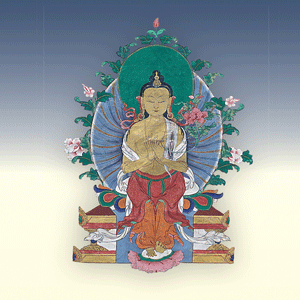
Also, in his Great Exposition of the Stages of the Path to Enlightenment (Lamrim Chenmo)Tsongkhapa presents the method for proper reliance upon the lama and lists the lama’s qualifications, particularly the ten qualifications of a Great Vehicle teacher. In this section Venerable Tsongkhapa responds to a passage from the teachings of Geshe Potawa, the Kadampa master, where the question is raised: "What if the person whom you are thinking of taking on as your spiritual teacher does not possess all these qualifications? What minimum qualifications should we seek in such a person?" Tsong-khapa gives the answer that the most important qualification is compassion for the students. As long as that person has this quality, even a single instruction that the teacher might give will be beneficial to the students. The other nine qualifications, such as skill, are necessary, but compassion is the principal quality required.
In this section Venerable Tsongkhapa also mentions nine attitudes that we must adopt when relating to our lama. To illustrate one of these attitudes, he says that we should behave like very obedient children behave toward their father. Whatever such children do, they always take into consideration the wishes of their father, and totally give themselves over to their father’s control. (This example reflects the way people thought at a certain time in India, not necessarily in today’s America.) Having said that, Venerable Tsongkhapa makes the very significant point that this analogy is made from the viewpoint of how we must relate to a fully qualified lama. He says that it is therefore very important to bear in mind that we should not simply be "led by the nose" by just anyone. In Tibetan these words are very powerful. There is a Tibetan saying that we should not allow just anyone to take the rope which is tied to our nose. This expression might have come from the Tibetan custom of tying a rope through the nose of yaks and other animals to enable the owner to lead the animal anywhere. So Venerable Tsongkhapa’s point is that we should not let just anyone have authority over us. I always refer to this quotation because it is very clear.
Furthermore Venerable Tsongkhapa substantiates his point with a quote from sutra which states, "Act in accord with that which is virtuous; do not accord with that which is not," Then in response to the question, "Is that'only in the case of the sutra path?" Venerable Tsongkhapa answers that it is the same for the tantric path as well, and supports this by citing the following quotation from the Fifty Verses of Guru Devotion, "If we find that [an instruction] is not proper through reasoning, we should say something in reply."
After Venerable Tsongkhapa gives the quote from the Cloud of Jewels Sutra, he mentions that "the meaning of not engaging in that which is improper is clarified in the Twelve Buddha Birth Stories.'' According to the birth story to which Venerable Tsongkhapa refers, Buddha was once born as a brahmin in India. One day his teacher decided to test some of his students, and summoned them to him. He said, "Nowadays I’m having very serious financial problems. Therefore you students should think about my situation."
The students replied, "Now that you are in such difficulty, we will do whatever you ask us to do."
The teacher said, "I should say something to you but you won’t do what I say."
They all protested, "We will certainly do it."
The teacher then said, "It is said, ‘When a brahmin is declining in his fortune, it is virtuous to steal.’ Brahma, the creator of the universe, is the father of all brahmins. When a brahmin is declining in fortune, it is all right to steal, because everything is Brahma’s creation, and the brahmins own those creations. Thus it is said, ‘When a brahmin is declining in his fortune, it is virtuous to steal.’ Therefore, please go and steal something."
Most of the students replied that they would do just as the teacher said, but the student who was to become Shakyamuni Buddha remained silent.
The teacher asked him, "You are my student. When I have such difficulty, why are you not saying anything?"
The student said, "You, my teacher, have instructed us to steal, but according to the general teachings stealing is completely improper. Although you have said to do it, it doesn’t seem right."
The teacher was very pleased and said, "I said this in order to test you all. He is the one who has actually understood my teaching. He has not been led foolishly anywhere like the front of a rivulet of water, but has examined what his teacher has said, and made his own determination. He is the best among my students."
Therefore, if we have understood well the complete approach to the path in the Great Vehicle scriptures, there will be no problems. But the lama also has to be cautious. Therefore as a concluding remark, after mentioning the qualifications of the lama in this section on proper reliance on the spiritual teacher, Venerable Tsongkhapa says that those who wish to seek students and become teachers must examine whether they have all these qualifications, and then achieve those that they lack. Similarly the students who wish to seek a lama must also examine whether the potential lama has these qualifications, and rely on a lama who has them. Otherwise, if the student is ignorant of these factors and then comes into contact with a teacher who is also very presumptuous and greedy, both are put in a very difficult position.
At the end of the section on special insight in the Great Exposition, Venerable Tsongkhapa mentions that if disciples have strong faith but do not have intelligence, they can be led foolishly anywhere, just like the front of a rivulet of water. They will do whatever they are told. We should not be like this.
We should understand these points. So, I think it is very important to make people aware of these points by writing articles in papers, journals, and so on, especially when you know that there is some danger to the integrity of the teachings because of cases where people have taken on the role of teacher and then exploited the trust of their students.
Do you have any further questions regarding this point?
Vikki Urubshurow: In the biography of the famous Naropa there are many seemingly unethical acts. Why is this such an important text?
His Holiness: I always say that if it is a case of the teacher being as highly qualified as Tilopa, and the student being as highly qualified as Naropa, then it is completely exceptional. However, it is very difficult to find a teacher who has such high qualifications as Tilopa and also very difficult to find a student who has the qualifications of Naropa.
There is a Tibetan saying that states, "If the fox tries to jump where the lion can jump, the fox will break its spine."
When teachers give instructions on how to practice proper reliance on the spiritual teacher, they emphasize different points of the practice. Some teachers assume that the teacher and the student have the complete qualifications, and stress following such good examples of the teacher-disciple relationship as those of Naropa and Tilopa, Milarepa and Marpa Lotsawa, and Shon-nu-nor-sang and his teacher. Nowadays, it is a time of unfavorable conditions. Therefore, Venerable Tsongkhapa’s approach is more well-balanced. This is very important to understand.
It is dangerous to assume that you can give instructions on the practice of faith and the use of pure perception (dog snang). Rather it is better that both the teacher and disciple examine one another, using analysis just as we do when studying the philosophical texts. Isn’t this approach much more reliable?
More on the student-teacher relationship:
The Teacher-Student Relationship
$24.95 - Paperback
By: Jamgon Kongtrul Lodro Taye & Ron Garry & Ven. Gyatrul Rinpoche & Lama Tharchin
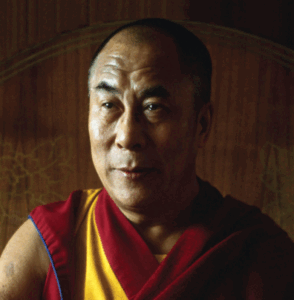 His Holiness the Fourteenth Dalai Lama is considered the foremost Buddhist leader of our time. The exiled spiritual head of the Tibetan people, he is a Nobel Peace Laureate, a Congressional Gold Medal recipient, and a remarkable teacher and scholar who has authored over one hundred books.
His Holiness the Fourteenth Dalai Lama is considered the foremost Buddhist leader of our time. The exiled spiritual head of the Tibetan people, he is a Nobel Peace Laureate, a Congressional Gold Medal recipient, and a remarkable teacher and scholar who has authored over one hundred books.
Books by H.H. The Dalai Lama
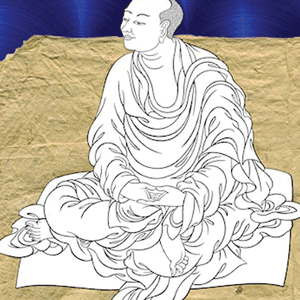
The Gelug Tradition of Breath Practice
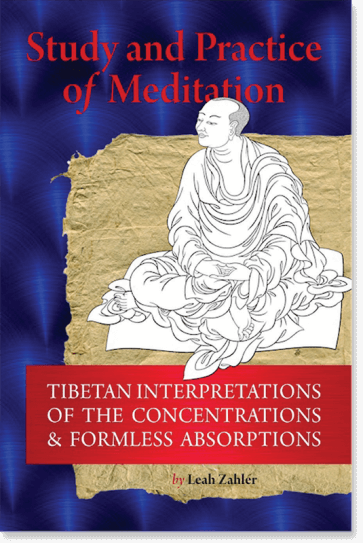
As a basic explanation for beginners, Lati Rinpoche gives a simplified presentation of breath meditation similar to the one Gedün Lodrö gives under the topic “the settling down of the winds.” However, Gedün Lodrö presents the settling down of the winds as a three-stage process in which the first two stages are watching and counting, whereas Lati Rinpoche distinguishes between watching and counting according to the faculties of the meditator; according to him, meditators of dull faculties have to count, whereas meditators of sharp faculties are able to watch the breath without counting. Both Gedün Lodrö’s and Lati Rinpoche’s explanations are intended to serve not only as introductory presentations of the Ge-luk system according to their respective colleges’ textbooks but also as practical instruction for beginning meditators.
—Adapted from Study and Practice of Meditation
Related Books from the Gelug Tradition

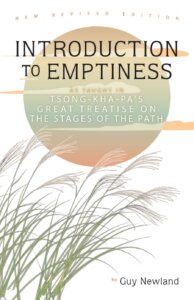
Tsong-kha-pa explains that when we understand the compatibility of dependent arising and emptiness, we see that nihilistic misreadings of Madhyamaka in fact have much in common with the eternalist extremes of those who cling to the idea of intrinsic nature. To understand this, consider that the basic question—the compatibility of emptiness and dependent arising—can be posed as follows: Can A produce B when A is empty? If A is devoid of intrinsic nature, how can it produce B? Suppose that A, the cause, is a seed and B, the effect, is a sprout. Now let’s consider three answers to these questions: (1) the answer of the essentialists (including many Buddhists), (2) the answer of those who, in interpreting Madhyamaka, negate too much, and (3) the answer of Tsong-kha-pa.
Essentialists: A seed cannot produce a sprout if the seed is empty of intrinsic nature. If the seed does not have, in its intrinsic nature, the capacity to produce a sprout, then a sprout will not be produced from the seed. Since sprouts are produced, we know that their causes, seeds, must have in their essential nature the power to produce sprouts.
Those who negate too much: We agree that a seed cannot produce a sprout when the seed is empty of intrinsic nature. If the seed does not have, in its intrinsic nature, the capacity to produce a sprout, then a sprout will not be produced from the seed. However, Madhyamaka analysis shows that seeds have no intrinsic nature; thus, it follows that sprouts are not produced. All production, all existence, is a delusion.
Tsong kha pa: A seed can produce a sprout when the seed is empty of intrinsic nature, as is frequently observed in the world. A seed does not need an intrinsic nature in order to produce a sprout. In fact, it is only because seeds lack intrinsic nature that dependent arising can take place as observed.
From Introduction to Emptiness: As Taught in Tsong-kha-pa’s Great Treatise on the Stages of the Path by Guy Newland

Running (Well) On Empty: An Interview with Guy Newland
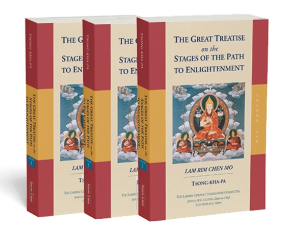
Emptiness is perhaps the most important—yet difficult to define—topic in Buddhism. Guy Newland, author of Introduction to Emptiness—a kind of every-person’s guide to the intricacies of various explanations of emptiness—based his book on The Great Treatise on the Stages of the Path: The Lamrim Chenmo by Tsong-kha-pa, of which he was the editor. Here he talks about really understanding emptiness, and why it’s important.
Christine Cox: You’re known for being able to convey the complexities about what emptiness is—and isn’t—in fresh ways that most people can understand. Have you had students who hear about emptiness, get a taste of it, and freak out? As in Omigod, what happened to my world?
Guy Newland: I do hear stories about people who, when they hear about emptiness, their hair stands up and they begin to cry. They feel that they’ve come home. My students haven’t reacted that dramatically, but some get very excited because the ideas about emptiness express something that they somehow always knew about the world but didn’t have a way to say. That makes sense to me [laughs]. We’re full all the time with all the information we need to refute our wrong views. We walk around as a bundle of contradictions, in a certain sense. It’s not surprising that some people would say Oh yes, this finally helps me make sense of the confusion I’ve had about how things are.
CC: On the other hand, perhaps there are people for whom emptiness teachings may not be currently helpful.
GN: People who are having psychological problems already of one sort or another, whether it’s issues with their own sense of identity or difficulties feeling any sense of boundaries between themselves and the world, probably should not be spending a lot of time thinking about emptiness.
CC: In your book you use an ingenious array of examples—from burning one’s mouth on pizza to dueling attorneys (to explain how Bhavaviveka and Chandrakirti’s views differ!)—to demonstrate quite subtle points about emptiness.
GN: Using things that are part of people’s common experience works well. For example, students can recognize that when they’re filled with desire, the object of their desire seems to be intrinsically or naturally appealing. As soon as you can see that, you’re on to identifying the object of negation. It really helps to get a sense that distorted ways of seeing things as having their own intrinsic nature is how we ordinarily look at the world. And that comes to the fore when we have strong afflictions present.
CC: This is probably an unfair question, but how would you encapsulate the various views on emptiness in Buddhism?
GN: Well, some traditions focus on the idea that emptiness is the absolute reality, the fundamental thing that exists, and that other things that appear are illusions. The practices involve allowing the fundamental purity that is the nature of things to shine out. I think that’s a common way to practice in Tibetan Buddhism; you can find parallels to it in other Mahayana traditions outside of Tibet as well.
And then there is another way of looking at things. It doesn’t disagree with that, exactly, but it shifts the focus a little and says, well, nothing absolutely exists. Nothing, including emptiness, exists in and of itself. Everything exists only conventionally because everything exists only interdependently. This is fundamentally true of even emptiness itself. That’s what Nagarjuna said; that’s what he meant when he said not to take dogmatic views of emptiness. He meant not to reify emptiness as an absolute essence. Therefore, in this view, emptiness is another conventionally existing thing. All things exist conventionally. Emptiness is the name that we give to one particular existing thing: the fact that nothing exists ultimately. And that’s a very different way of talking about things.
 This latter way of talking about things predominates in Nagarjuna’s Fundamental Treatise and in Chandrakirti and in Tsong-Kha-pa’s Great Treatise. These texts are not opposed to the idea of saying that emptiness is the fundamental reality. They do believe that emptiness is the final nature of things. But they want to avoid having that be understood as an absolute essence.
This latter way of talking about things predominates in Nagarjuna’s Fundamental Treatise and in Chandrakirti and in Tsong-Kha-pa’s Great Treatise. These texts are not opposed to the idea of saying that emptiness is the fundamental reality. They do believe that emptiness is the final nature of things. But they want to avoid having that be understood as an absolute essence.
I could probably boil it down: Do you think of emptiness as a kind of absolute essence of pure mind? Or do you think of it as the lack or absence of any essence? Anywhere? At all? Which way do you want to approach this? They’re really different, I think. Both of these views have scriptural basis in the Mahayana. Both of them have strong practice lineages in Tibet. I think HH the Dalai Lama has made a large effort in some of his teachings, such as in Kindness, Clarity, and Insight, to try to bridge these and show that they are both legitimate aspects of the Mahayana tradition and that people should see that these are both medicines that are in the Buddhist pharmacy, not distortions of the dharma.
CC: Understanding emptiness—not only conceptually but also experientially—seems to be a prerequisite for many Buddhist practices, certainly for tantra. How deep a realization of emptiness is needed before one begins the tantric path?
GN: It seems to me if you’re getting into self-generation as a deity, that should be done on a foundation of understanding emptiness, or you open yourself to danger in the practice when you’re visualizing yourself as a divine being. You have to understand that it’s an empty divine being—it’s a problem if you don’t, right? Good teachers understand that, but what they choose to do with it in terms of how they actually teach their students could be different.
For example, Lama Yeshe would say that it’s not expected that all students will have already realized emptiness as they start to do visualizations. So he would suggest that they think of space as a way to imagine emptiness. This recommendation has a scriptural basis—it says in one of the Perfection of Wisdom sutras that space is the best example people can use to think about what emptiness is like.
CC: In Great Treatise, on which your book is based, Tsong-kha-pa puts forward the idea that conceptual thought is not the root cause of our problems, but rather a tool for liberation.
GN: Of course that’s an absolutely core idea in the book. People sometimes have the idea that if they would simply stop thinking about things—sort of bury their heads in the sand—that problems would go away. They think that all that’s needed is to practice a deep kind of concentration—very, very focused and one-pointed. It could be a very peaceful state of mind that relieves us of all our ordinary troubles.
The wish to do this is deeply in us—kids will go on a merry-go-round until they’re dizzy just to stop their ordinary experience, or roll down a hill—which is what I did as a kid. Something within just wants a break from the constant talking in our heads—which can lead to sex or drugs or drumming, for example. The problem, of course, is that it doesn’t get at the root of our problems. If we don’t strengthen our thinking and analyze more carefully, then we don’t get at what’s really causing our suffering. Then as soon as the non-conceptual vacation is over, we come back to the same problems that we had before. They haven’t changed at all.
If the suffering world is only a thought-construction, then stopping thought does seem to be the most liberating move. Yet as Tsong-kha-pa famously argues, another step beyond this, seeing that not thinking is not enough, is at the very heart of what it means to be a Buddhist. Other religions have profound ethics, and techniques for accessing amazing non-conceptual states, but Buddhism claims the distinction of a penetrating analysis of how the world exists. Only by engaging this analysis, and engaging it conceptually, does one create the basis for real liberation from unnecessary misery. As Ch’an master Sheng Yen teaches, practice is not about stopping thought, for if it were, your teacher could just whack you in the head with a hammer.
CC: It sometimes feels that way…
GN: Yes! Once you have this understanding of how things exist, developed through careful analysis, you use the power of mental focus, developed in concentration and meditation, and make this understanding of emptiness the focus of your practice. That way you combine these two kinds of Buddhist meditation—the kind that involves focusing your mind and making it a powerful instrument, and the analytical power, discriminating and discerning and working out exactly how things exist. This is the path of preparation, preparing yourself to go into nirvana.
CC: Our editor described your book as being as close to a page-turner as a book on emptiness can get. I imagine you must have metabolized the various viewpoints on emptiness through yourself in order to present them so clearly.
GN: First of all, I was the main editor of Volume Three of the Great Treatise. It was a big challenge. That part of the book wasn’t written as an introduction; it was written for other scholars within the tradition to make it clear exactly what distinctions Tsong-kha-pa had sorted out and exactly how they were based in the Indian shastras. As a translator I had to understand it; one can’t just put the words into English without knowing what he’s saying. What I tried to do in Introduction to Emptiness is explain the ideas as I would to students—whether at universities or dharma centers. I had to say to myself, hey, what’s Tsong-khapa’s real point here and how can I express it in a way my readers will understand?

